
Press Enter to search

How To Write A One-Page Resume
Recruiter-backed advice on building a one-page resume that still showcases all your essential skills by condensing statements, reducing margins, combining headings and tailoring your roles.
5 months ago • 6 min read
So, you’re facing the challenge of creating a high-performing resume that showcases your essential skills but still fits onto one page. You don’t want to omit anything relevant, but how do you fit everything into one page without cutting important details?
To condense your resume to one page, focus on recent, relevant experience and remove anything not directly related to the application. You can also reduce your margins, merge related sections, and eliminate any duplicate information.
In this article, we’ll discuss why it's preferable to write a one-page resume, how to choose what to cut and what to include, and how to organize your resume to maximize readability and maintain a professional look.
Do you really need a one-page resume?
The short answer is yes and no. While it's not wrong to have a two-page resume, modern recruiters only spend an average of 7 seconds reviewing an application. With a two-page resume, a recruiter will spend less time reading each page, so it’s better to write one great page than two mediocre ones.
But surely it's better to include more information than less? Actually, no. The more you give a recruiter to read, the harder it is for them to pick out the information they want. While you might be tempted to include everything you've ever accomplished, it's far more useful to determine what a recruiter is looking for and showcase these skills upfront.
For most applications, a one-page resume is best , especially for entry-level positions or students. Only consider a two-page resume if you’re a senior professional with extensive relevant experience. Never make your resume three or more pages ; It just won't be read.
If you're wondering whether your one-page resume effectively showcases all relevant experience and skills or if it should extend to two pages, upload it to the tool below for tailored insights on optimizing length and content.
How to make your resume one page
Knowing how to make your resume shorter is as much about knowing what to cut as what to include. The key is to be concise and direct, and only include your most impressive achievements. You might think you can't fit your resume on one page now, but even the longest resume can be trimmed down with a little targeted editing.
Tailor your resume to each application
The number 1 rule for fitting your resume onto one page is to tailor your experience to each application by only including information directly relevant to the job you're applying for. This means evaluating everything on your resume and only selecting roles and accomplishments that showcase the specific skills the new position is looking for.
For help targeting your resume, use our Targeted Resume tool to scan your resume for relevant keywords and receive personalized feedback on areas that can be improved.
Reduce margins and font size
You can reduce your page margins to 0.5 inches and font to 11 or 10 points to give yourself a little more room when trying to fit everything onto one page. But don't use a font smaller than 10, or margins less than 0.5, as this will make your resume cramped, harder to read, and overall less professional.
Remove duplicate information
When describing work experience, remove redundancy by combining statements and bullet points that discuss similar points. This will help you reduce unused space while also making strong, concise statements.
For example, the two bullet points below both discuss project management skills and describe similar roles and responsibilities:
- Led a cross-functional team in project planning, scheduling, and execution.
- Managed project budgets and ensured financial goals were met.
To reduce space, combine these two points into one sentence:
- Spearheaded cross-functional project teams, overseeing planning, scheduling, and budget management to consistently meet financial goals.
Cut irrelevant sections
Remove outdated resume sections that don't directly add to your application. Resume sections to consider cutting include:
- Objective statement: Replace your objective statement with a targetted resume summary , or simply remove it altogether. Modern recruiters are more interested in what you can bring to the table than what you're looking for in a position.
- References: Employers will ask for references when it's relevant and don't expect them to be included on your resume.
- Hobbies and interests: This section is often irrelevant to your application and can be cut to maintain clarity and relevance. Replace hobbies with skills that explain your abilities rather than your interests.
- High school information: If you have completed further/higher education, your high school details are generally no longer relevant and can be removed entirely.
- Education details: If you're a mid to senior-level professional with enough relevant work experience, reduce your education section to only your most recent accomplishments and degree.
- Volunteering: Though helpful for entry-level candidates, if you have enough paid experience for your application, remove any volunteering work and focus on paid roles.
Prioritize your most recent experience
Remember, you don't need to include every job on your resume, especially entry-level and short-term positions. Prioritize your most recent experience and focus on jobs that showcase relevant skills and quantifiable achievements. Remove any experience, education, and qualifications over ten years old unless it's specifically relevant to your application.
Make the most of each line
While you don't want to cram your resume so full of text it becomes hard to read, you can use some specific techniques to save space where it counts.
For example, when creating your resume header , instead of listing your address, phone number, and contact information on separate lines, combine all this information into one line, separated by dashes (-), dots (∙), or vertical bars (|). This creates a professional-looking header that reduces wasted space at the top of your resume, as shown in the example below.
You can save space by using a semicolon (;) to separate information on the same line. This is especially helpful in your education and qualifications sections, as shown below.
You can also use a semicolon to separate different subsections within your Skills or Additional Information sections, such as varying skill proficiency levels , as shown below.
Combine similar sections
If you have multiple sections to your resume that include a small amount of relevant information, consider combining your headings to make a more compact and streamlined document.
Work experience, volunteering, and professional projects can be combined into an "Experience" section to showcase all your relevant work experience, and education, certificates, and qualifications can be combined under one "Education" section.
Use an "Additional Information" section
"Additional Information" is a helpful section to highlight extra information relevant to your application that doesn't fit into other standard resume categories. Combining this extra information under one heading helps reduce space taken up by section headings and improves the readability of your resume.
Additional information should be listed at the bottom of your resume, and can include:
- Language skills
- Technical skills (if not including a specific skills section)
- Certificates, qualifications, and additional training
- Awards and achievements
- Volunteering or unpaid experience
- Publications
- Personal or professional projects
- Interests and hobbies
One-page resume examples
Here are some examples of optimized one-page resumes for entry-level and mid-level applicants. For more examples, head to our Resume Worded template library to browse and download various professional resume templates.
Here is an example of an entry-level one-page resume:
And here is an example of a senior-level one-page resume:
- Career Advice
Spread the word
How to right-align dates for a professional looking resume (and why), how to write an “about me” section on your resume (with examples), keep reading, how to show bilingualism on your resume (with examples), oops what to do if there’s a mistake on your resume, getting the basics right: resume line spacing, subscribe to our newsletter.
Stay updated with Resume Worded by signing up for our newsletter.
🎉 Awesome! Now check your inbox and click the link to confirm your subscription.
Please enter a valid email address
Oops! There was an error sending the email, please try later

Thank you for the checklist! I realized I was making so many mistakes on my resume that I've now fixed. I'm much more confident in my resume now.

- Career Blog
One Page Resume: The Ultimate Guide and Examples for 2024

A one page resume is a shortened, condensed version of a traditional resume that highlights key skills and experiences on a single page. This format is becoming increasingly popular due to its ease of use and ability to quickly communicate important information to potential employers.
Why Should You Use a One Page Resume?
With the job market becoming more competitive, job seekers need to find ways to stand out from the crowd. A one page resume is a great way to do this. It allows you to showcase your most relevant skills and experiences to potential employers without overwhelming them with unnecessary information.
Benefits of a One Page Resume
There are many benefits to using a one page resume, including:
Increased readability: A one page resume is easier to read and digest than a longer, more complicated resume.
Improved chances of getting noticed: With so many job applications flooding in, employers are more likely to take notice of a concise, well-crafted one page resume.
Ability to highlight key skills and experiences: By focusing on the most relevant information, job seekers can better showcase their qualifications to potential employers.
Simplified application process: Many recruiters and hiring managers prefer one page resumes because they are easier to handle and manage.
A one page resume is an effective way to present your qualifications and stand out in a competitive job market. By carefully crafting your one page resume, you can increase your chances of catching the attention of potential employers and landing your dream job.
Researching and Preparing Your Resume
When it comes to creating a one-page resume that stands out from the crowd, a significant part of the process is researching and preparing your resume. This section will cover four critical areas: knowing your audience, identifying your transferable skills, understanding resume formatting, and choosing the right font.
A. Knowing Your Audience
Before diving into writing your resume, you need to know your audience. The person who will be reviewing your resume will be looking for specific skills and qualifications based on the job that they are hiring for. Research the company you are applying to and try to understand their needs and values. This will help you tailor your resume to the specific job and stand out from other applicants.
B. Identifying Your Transferable Skills
Transferable skills are those that can be used in various professions and industries. Identifying your transferable skills is crucial when creating a one-page resume. These skills may include communication, teamwork, leadership, and problem-solving. Be sure to highlight them in your resume, as they will be important to the person reviewing your application.
C. Understanding Resume Formatting
Resume formatting can play a significant role in whether your resume gets noticed or not. Use bullet points, headings, and proper spacing to make your resume visually appealing and easy to read. Be consistent with your formatting, use a clear and concise language, and avoid using jargon or buzzwords. Keep in mind that your resume should be easy to scan, and the most important information should be at the top.
D. Choosing the Right Font
Choosing the right font may seem like a minor detail, but it can impact the overall look and feel of your resume. Use a font that is easy to read, such as Arial, Times New Roman, or Calibri. Avoid using decorative or script fonts, as they can be difficult to read. Keep your font size between 10-12 points, and use bold or italics for emphasis.
Researching and preparing your resume is an essential part of creating a one-page resume that stands out. By knowing your audience, identifying your transferable skills, understanding resume formatting, and choosing the right font, you can create a resume that showcases your strengths and increases your chances of getting hired.
Writing Your One Page Resume
As a job seeker, the ultimate goal is to catch the attention of potential employers and showcase your professional value. In the age of information overload, the one page resume has become a vital tool to communicate a condensed representation of your experience and achievements. In this section, we will guide you through the essential sections of your one page resume: crafting your professional summary, highlighting your relevant experience, showcasing your achievements, and including your education and certifications.
A. Crafting Your Professional Summary
Your professional summary is the first thing that recruiters will see in your resume. Creating a compelling and engaging summary will help you to stand out from other applicants. Keep in mind, that it should be concise, focused and relevant to the position you’re applying for.
Some key elements to consider when writing your professional summary are:
- Highlight your top skills, expertise, and experience.
- Mention your most relevant accomplishments.
- Use industry-specific keywords and phrases to demonstrate your knowledge.
- Communicate your career aspirations.
As a rule of thumb, your professional summary should be no longer than 3-4 lines. This section is often called the elevator pitch, think of it as an objective statement to capture the reader’s attention and encourage them to read more.
B. Highlighting Your Relevant Experience
Highlighting your relevant experience means focusing on the most relevant job experiences, skills, and accomplishments related to the job you’re applying for. Remember to switch throughout your resume to a results-oriented approach. Detail how you contributed and added value to your previous roles.
The key to highlighting relevant experience is to tailor your resume to the job description. Read the job description carefully, identify the requirements and qualifications, and use them as a guide to showcase your relevant work experience.
C. Showcasing Your Achievements
Your achievements demonstrate how you’ve contributed to and impacted the organizations you’ve worked for. When showcasing your achievements, use active language and strong verbs that showcase your success.
Here are some tips to help you showcase your achievements:
- Quantify your accomplishments with numbers, facts, and figures.
- Use bullet points to make it easier to read and present information in a structured way.
- Use persuasive language that demonstrates your ability to exceed expectations.
- Highlight achievements that are most relevant to the job position you’re applying for.
D. Including Your Education and Certifications
Your highest level of education and professional certifications can demonstrate your qualifications and your commitment to your profession. Depending on the position, this section can be placed before or after professional experience. When writing this section, make sure to highlight the relevant qualifications and certifications that are most relevant to the job you are applying for.
Writing a one page resume requires crafting a professional summary that highlights your top skills and expertise, focusing on relevant experience while showcasing your most significant achievements, and demonstrating your qualifications and certifications.
Tips for Optimizing Your One Page Resume
As technology continues to advance, it is becoming increasingly important to optimize your one-page resume to ensure that it stands out in the crowded job market. Here are four tips to help you optimize your one-page resume:
A. Incorporating Keywords
Keywords play a critical role in ensuring that your one-page resume is noticed by hiring managers and recruiters. To determine which keywords to use, take a close look at the job description and identify the skills and qualifications that are required for the position. Use those keywords throughout your resume, including in your summary, education, work experience, and skills sections.
B. Utilizing Action Words
When writing your one-page resume, it is important to use strong action words to describe your accomplishments and duties. Use words such as “achieved,” “managed,” “created,” or “implemented” to convey your achievements and responsibilities. This not only highlights your past accomplishments but also gives a glimpse of your potential impact on future employers.
C. Quantifying Your Accomplishments
While it is crucial to highlight your duties and responsibilities in your one-page resume, it is equally important to quantify your achievements. Use numbers or percentages to showcase your impact in previous roles. For example, instead of saying “led a team,” say “managed a team of ten employees, resulting in a 30% increase in productivity.” This approach highlights the value you bring to the table and can set you apart from other candidates.
D. Tailoring Your Resume for Each Job Application
Finally, tailor your one-page resume to each job application you submit. This includes using the keywords, action words, and quantified accomplishments that are relevant to the role. Be sure to also highlight how your skills and experience align with the job requirements, and customize your resume to match the company’s culture and mission.
Optimizing your one-page resume by incorporating keywords, utilizing action words, quantifying your accomplishments, and tailoring it to each job application can significantly improve your chances of landing a job interview. Use these tips to create an effective one-page resume that catches the eye of recruiters and hiring managers.
Examples of One Page Resumes
In this section, we will provide you with three examples of one page resumes for entry-level, mid-career, and executive positions. These examples will give you an idea of how to tailor your resume based on your experience level and the position you are applying for.
Example #1: Entry-Level Position
123 Main Street | City, State | (123) 456-7890 | [email protected]
Motivated and detail-oriented recent graduate with a Bachelor’s degree in Business Administration seeking an entry-level position in the finance industry. Strong analytical skills, solid understanding of financial principles, and a demonstrated ability to work in a team environment. Eager to contribute to the success of a dynamic organization and gain practical experience in financial analysis and reporting.
- Bachelor of Business Administration (Finance)
- XYZ University
- City, State
- Graduation: Month Year
- Financial analysis
- Data analysis
- Budgeting and forecasting
- Financial modeling
- Microsoft Excel
- Communication
- Problem-solving
Financial Analysis Project
- Conducted comprehensive financial analysis on a publicly traded company, including ratio analysis, trend analysis, and financial statement interpretation.
- Prepared a detailed report summarizing the company’s financial performance and providing recommendations for improvement.
- Presented findings to a panel of faculty members and industry professionals.
Intern | ABC Company
City, State | Month Year – Month Year
- Assisted the finance team with various tasks, including data entry, financial report preparation, and expense tracking.
- Collaborated with colleagues to analyze financial data and identify trends and patterns.
- Contributed to the development of financial models and forecasts to support decision-making processes.
Certifications
- Financial Modeling Certification
- Microsoft Excel Certification
- Fluent in English and Spanish
Example #2: Mid-Career Position
Sarah Johnson
456 Elm Street | City, State | (123) 456-7890 | [email protected]
Results-driven finance professional with 7+ years of experience in financial analysis, budgeting, and strategic planning. Proven track record of optimizing financial performance, implementing cost-saving measures, and driving business growth. Strong analytical skills, leadership abilities, and expertise in financial modeling and forecasting. Seeking a mid-career position in a progressive organization to utilize skills and contribute to the achievement of financial objectives.
Financial Analyst | XYZ Company
City, State | Month Year – Present
- Conduct financial analysis to identify trends, assess performance, and provide recommendations for improvement.
- Develop and maintain financial models for budgeting, forecasting, and variance analysis.
- Collaborate with cross-functional teams to analyze business cases, assess investment opportunities, and support decision-making processes.
- Prepare and present financial reports and presentations to senior management.
- Streamline financial processes, resulting in improved efficiency and accuracy.
Senior Accountant | ABC Company
- Managed the company’s financial accounting processes, including general ledger maintenance, reconciliations, and month-end close activities.
- Prepared financial statements, budgets, and forecasts.
- Implemented internal controls and ensured compliance with accounting principles and regulations.
- Led a team of junior accountants, providing guidance and support in day-to-day operations.
- Master of Business Administration (Finance)
- Financial analysis and modeling
- Strategic planning
- Financial reporting
- Cost analysis
- Process improvement
- Team management
- Advanced Microsoft Excel
- ERP systems (SAP, Oracle)
- Certified Financial Analyst (CFA)
- Certified Management Accountant (CMA)
Example #3: Executive Position
Michael Thompson
789 Oak Street | City, State | (123) 456-7890 | [email protected]
Accomplished executive with over 15 years of experience in senior leadership roles, driving business growth, and delivering exceptional results. Proven track record of strategic planning, operational excellence, and building high-performing teams. Skilled in financial management, business development, and organizational leadership. Seeking an executive position to leverage expertise and drive continued success in a dynamic and challenging environment.
Chief Financial Officer (CFO) | XYZ Corporation
- Oversee all financial operations, including budgeting, forecasting, financial reporting, and risk management.
- Develop and implement financial strategies to drive business growth and maximize profitability.
- Provide strategic guidance to senior leadership in decision-making processes.
- Lead a team of finance professionals, fostering a culture of excellence and continuous improvement.
Vice President of Business Development | ABC Inc.
- Led the business development function, identifying and pursuing new growth opportunities.
- Developed strategic partnerships and negotiated key contracts to expand the company’s market presence.
- Conducted market analysis and competitive intelligence to inform strategic decision-making.
- Collaborated with cross-functional teams to launch new products and drive revenue growth.
- Financial management
- Business development
- Leadership and team management
- Change management
- Risk management
- Mergers and acquisitions
- Stakeholder relations
- Contract negotiation
- Board presentations
- Certified Public Accountant (CPA)
- Executive Leadership Program
Common Mistakes to Avoid
As you craft your one page resume, there are several pitfalls that you’d want to avoid. Here are the most common errors that job applicants commit:
A. Including Irrelevant Information
One typical blunder is inserting unrelated information into your resume. It’s vital to keep your resume relevant and insightful as possible. Only mention work experience, skills, and achievements that are aligned with the job you’re applying for.
B. Overusing Industry Jargon
While it’s essential to showcase your knowledge and expertise in your field, it’s also critical to balance it out with simple and understandable language. Using too much industry-specific jargon is a turn-off for hiring managers who are non-experts in your field.
C. Failing to Proofread
Submitting a document full of grammatical and spelling errors can lead to impression that you didn’t put much effort into your application. Always proofread your resume multiple times – or better yet, get someone else to do it for you.
D. Using a Generic Resume
Tinkering a general resume won’t guarantee success in landing your dream job. Instead of using a one-fits-all approach, customize your resume for every job application. This way, you can emphasize the qualifications and accomplishments that are relevant to the job you’re applying for.
By avoiding these common resume mistakes, you’re one step closer to creating a winning one page resume.
Formatting and Design Options
When it comes to crafting your one-page resume, formatting and design options can make a huge difference in the impression you make on potential employers. Here are some considerations to keep in mind when choosing the right resume template and incorporating design elements:
A. Choosing the Right Resume Template
There are many resume templates available online, ranging from simple and straightforward to creative and extravagant. When selecting a template, it’s important to consider your industry and the type of job you’re applying for. For example, a graphic designer might opt for a more visually appealing template, while an accountant might choose a more classic and conservative look.
In addition to aesthetics, it’s important to select a template that is easy to read and presents your information in a clear and concise manner. Remember, the goal of your one-page resume is to quickly and efficiently highlight your skills and experience – not overwhelm the reader with unnecessary details.
B. Incorporating Color and Graphics
While using color and graphics can add visual interest to your resume, it’s important to use these elements sparingly and purposefully. For example, using company colors or incorporating a small icon can help your resume stand out while still maintaining a professional appearance.
However, it’s important to avoid using too many colors or too much graphic design, as this can become distracting and make it difficult for the reader to quickly find key information. Remember, the focus should always be on your skills and experience, not on fancy design elements.
C. Using White Space Effectively
One of the most important design elements of any one-page resume is white space. When used effectively, white space can make your resume look clean, organized, and easy to read. Conversely, cramming too much information into a small space can make your resume appear cluttered and overwhelming.
To use white space effectively, consider breaking up your resume into sections and using headings and subheadings to clearly define each section. You can also use bullet points and lists to make information more easily digestible.
D. Creating a Professional Look and Feel
Ultimately, the goal of your one-page resume is to create a professional and polished impression on potential employers. This means paying attention to small details like font choice, spacing, and alignment.
When selecting a font, choose something simple and easy to read, such as Arial or Times New Roman. Avoid using decorative fonts or fonts that are difficult to read. Additionally, be sure to keep your spacing and alignment consistent throughout your resume to maintain a polished and professional appearance.
By taking the time to carefully consider your formatting and design options, you can create a one-page resume that effectively showcases your skills and experience in a visually appealing and professional manner.
One Page Resume vs. Two Page Resume
When it comes to resume writing, one of the most common questions job seekers ask is whether to use a one page resume or a two page resume. Depending on your work experience and industry, the answer may vary. In this section, we will explore the pros and cons of a one page resume, when to use a two page resume, and how to convert your two page resume to one page.
A. Pros and Cons of a One Page Resume
A one page resume is typically recommended for those who are just starting out in their careers or those who have less than 10 years of professional experience. Here are some pros and cons of a one page resume:
- It is concise and to the point, making it easier for recruiters to read and understand.
- It forces you to prioritize and focus on the most important information.
- It shows that you can communicate effectively and efficiently.
- It may not be enough space to include all of your relevant work experience and accomplishments.
- It may be challenging to highlight your skills and achievements in a short format.
B. When to Use a Two Page Resume
A two page resume is typically recommended for those who have extensive work experience, advanced degrees, or multiple certifications. Here are some scenarios when a two page resume may be appropriate:
- You have previous experience in different industries or roles that are relevant to the job you are applying for.
- You have achieved significant accomplishments, such as awards, publications, or patents.
- You have advanced degrees or professional certifications that are relevant to the job you are applying for.
C. How to Convert Your Two Page Resume to One Page
If you have a lot of experience and accomplishments that you want to include on your resume but are limited to one page, do not worry. There are ways to make your two page resume fit into one page. Follow these tips:
- Start by identifying the most relevant and significant accomplishments and experiences.
- Eliminate details that are not critical or that can be discussed during the interview process.
- Use bullet points and short phrases to highlight your accomplishments and skills.
- Use a smaller font size and adjust the margins accordingly.
Whether you should use a one page resume or a two page resume depends on your experience and the job you are applying for. A one page resume is great for those who are just starting out or have limited experience, while a two page resume is suitable for those with extensive experience or advanced degrees. If you have a two page resume but need to convert it to one page, follow the tips above to ensure that you highlight your most impressive qualifications and achievements.
ATS Compatibility
When it comes to job applications, understanding how ATS (Applicant Tracking Systems) work is crucial. These automated systems are designed to filter through resumes and select the most qualified candidates based on keyword matches and other criteria.
A. Understanding How ATS Works
To optimize your one page resume for ATS, you first need to understand how these systems function. Generally, ATS will scan your resume for keywords and phrases that match the job description. If your resume does not include these keywords, it may be instantly rejected by the system.
ATS also looks for specific formatting and organization. For example, it may have difficulty reading fancy fonts, text boxes, or tables. Additionally, ATS may struggle with resumes that include graphics or images.
B. Optimizing Your One Page Resume for ATS
To ensure that your one page resume passes the ATS screening, it’s important to prioritize including relevant keywords and phrases throughout your resume. This may mean tailoring your resume for each individual job application and incorporating industry-specific jargon.
In terms of formatting, it’s helpful to stick to simple, easy-to-read fonts and avoid using text boxes or tables. Instead, use concise bullet points to showcase your skills and experiences.
C. Testing Your One Page Resume with ATS
Before submitting your one page resume to any job applications, it’s a good idea to test it with ATS. There are several free online tools available that can simulate ATS screening, allowing you to see where your resume may be falling short.
By taking the time to understand how ATS works and optimizing your one page resume for these systems, you can increase your chances of getting noticed by potential employers and landing your dream job.
Reviewing and Refining Your One Page Resume
Once you have created your one page resume, it’s important to review and refine it before submitting it to potential employers. This section covers the steps you should take to ensure your resume is polished and ready to impress.
A. Getting Feedback from Others
One of the best ways to improve your one page resume is to get feedback from others. Reach out to colleagues, friends or family members who have experience in the industry you are applying for and ask them to review your resume. They might have valuable insights, suggestions or critiques that you can use to make your resume stand out.
B. Revising Your One Page Resume
Based on the feedback you receive, you should revise your one page resume accordingly. Ensure that your resume is visually appealing and easy to read, with clear headings and sections. Use action verbs and metrics to showcase your achievements and experience, and tailor your resume to the specific job you are applying for.
C. Proofreading Your One Page Resume
Before submitting your one page resume, it’s crucial to proofread it thoroughly. Look out for spelling and grammatical errors, missing information, or awkward phrasing. Double check that your contact information is accurate and up-to-date.
D. Finalizing and Submitting Your One Page Resume
Once you have revised and proofread your one page resume, it’s time to finalize it and submit it to potential employers. Save your resume as a PDF to ensure it looks the same across different devices and software. Keep in mind that your one page resume should be accompanied by a cover letter that highlights your interest in the position and why you would be a good fit for the role.
Reviewing and refining your one page resume is essential to making a strong impression on potential employers. Get feedback from others, revise your resume accordingly, proofread it thoroughly, and finalize and submit it with a cover letter that showcases your enthusiasm and qualifications for the job.
Related Articles
- Top Department Manager Resume Examples for 2023
- How to Mention Relocation in Cover Letter and Resume
- The Ultimate Store Manager Resume Guide: Examples & Tips
- Quality Assurance Technician Job Description: Complete Guide
- Top Careers for Communications Degree Graduates in 2023
Rate this article
0 / 5. Reviews: 0
More from ResumeHead


A Breakdown of a Successful One Page Resume – And How to Write Yours
In This Guide:
Should your resume be one page, how to fit 25 years of experience in a single page – william’s one-page resume., a ceo and co-founder’s one-page resume – how pavel fit his professional life on a single page., founder, director, and vp of product – gal’s double-column single-page resume., how to write your resume to fit on one page – a handful of actionable resume tips., key takeaways.

Having a one-page resume is possible, even if you have decades of experience behind your back.
In this article, we’ll analyze concrete examples of one-page resumes built by Enhancv users – from William, a Japanese entrepreneur with over 25 years of experience to Pavel whose professional background took him to three countries, and Gal that has spent a decade in the product management and business development world.
All three of them share one common thing – a single-page resume.
So, how do you fit that many years of experience into an effective resume without omitting important details?
Keep reading and you’ll learn:
- If your resume should be one page long.
- How to focus on relevant skills and experience to cut down your resume to a single page.
- Which resume sections are a must in single-page resumes.
Alex Lafreniere, a happy user, shared this:
“Hands down the best and most intuitive resume builder I've used. Go for the pro plan - it's the best bang for your buck. You get a lot more sections, which helps with the different variations of your cv, especially if you want to tailor it to different industries."
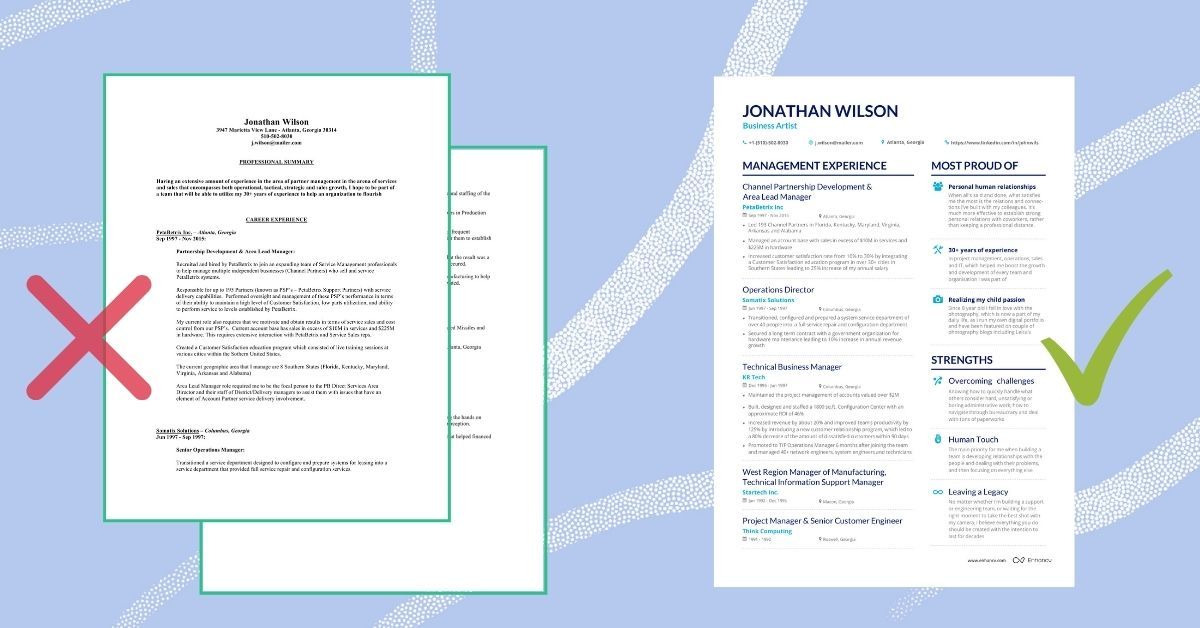
BUILD MY ONE PAGE RESUME
Yes, your resume can be one page, regardless of experience. Single-page resumes focus on the most relevant parts of your work history. Put important and relevant information first, as this makes for an efficient format for any professional field.
If you can’t fit all relevant experience on a single page, only then go for a two-page resume.
How to make a one-page resume if you have a ton of experience?
The secret to making a one-page resume when you have 10, 15, or even more than 20 years of work experience is to include information that’s highly relevant to the job you’re applying for.
Study the job description – hiring managers usually include what experience and skillset they’re looking for. Show that. Remember, that may mean you’ll have to make a tailored resume for each job position you apply for.
Thankfully, with Enhancv you can easily copy, edit and download your resumes as many times as you need. It also saves time that you don’t have to worry about design or layout – check our resume builder .
So, does a resume have to be one page?"?
A resounding no. Professionals with a lot of relevant experience in a field can benefit from two or even three-page resumes . If you’ve spent the past 15 years working as a business transformation manager and you have a lot of examples to communicate on your resume, then definitely go with a longer one.
Does it mean the one-page resume format is dead?
No. A resume should focus on your relevant experience and give insight into the impact you’ve had at previous companies you’ve worked for and give a glimpse into who you are .
Fit all three on a single page and you’ve got yourself a pretty impactful resume. In the examples we’re going to review below, we’ve made sure to analyze how each has made their resume.
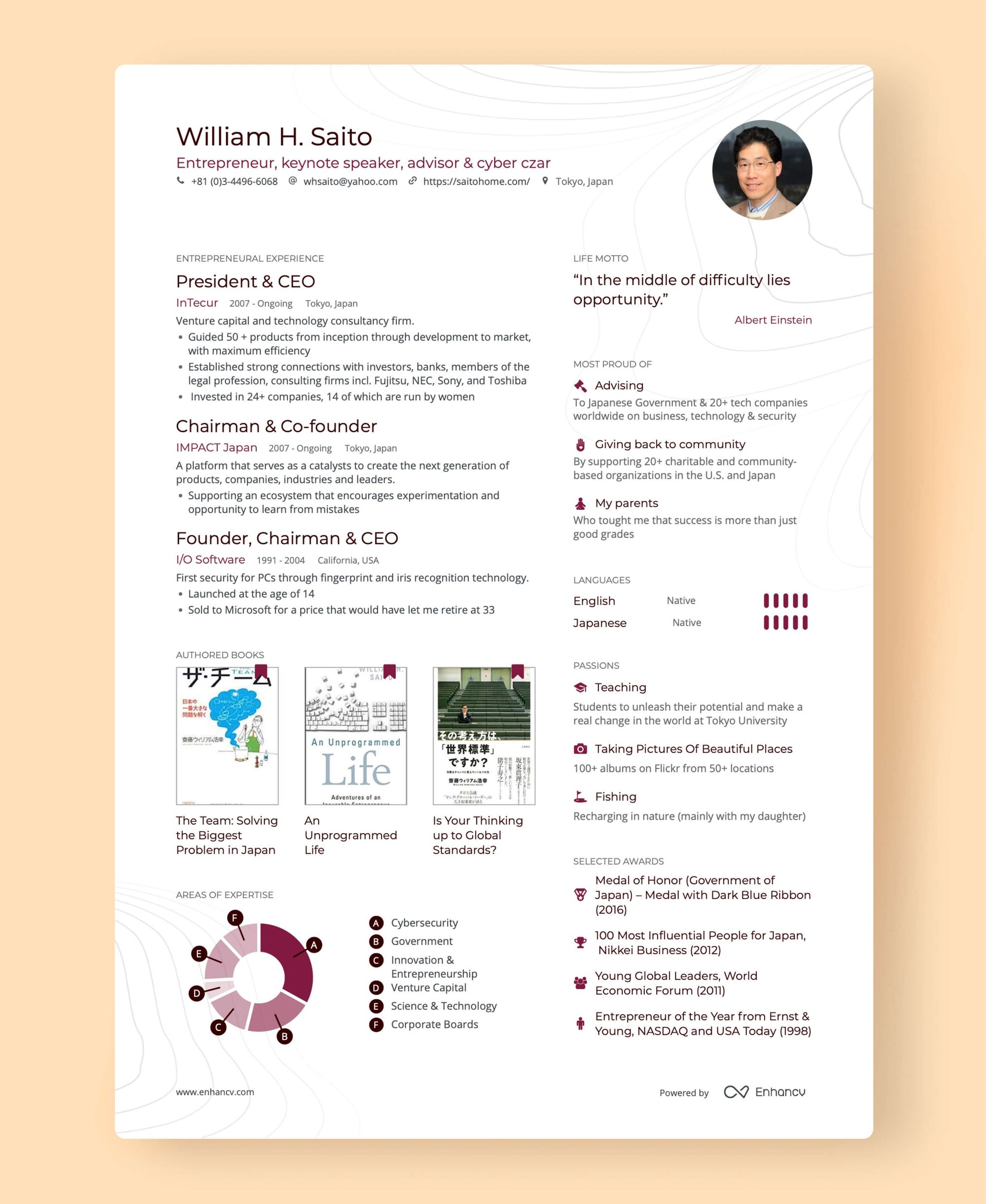
William’s single-page resume takes advantage of our compact resume format . The best way to fit more information on a single page is by browsing the Enhancv resume templates and choosing a two or three-column layout .
With a single click, you can fit around 50% more content on a single page, compared to what a Microsoft Word template allows you to do.
Still, William took things up a notch. Here’s what he did especially well when writing his resume.

Right under his name, William wrote what defines him as a professional: “Entrepreneur, keynote speaker, advisor & cyber czar’’. This quickly gives you an idea of the kind of jobs he’s held previously, and what is most significant about his career – all in seven words and contained to the resume header.
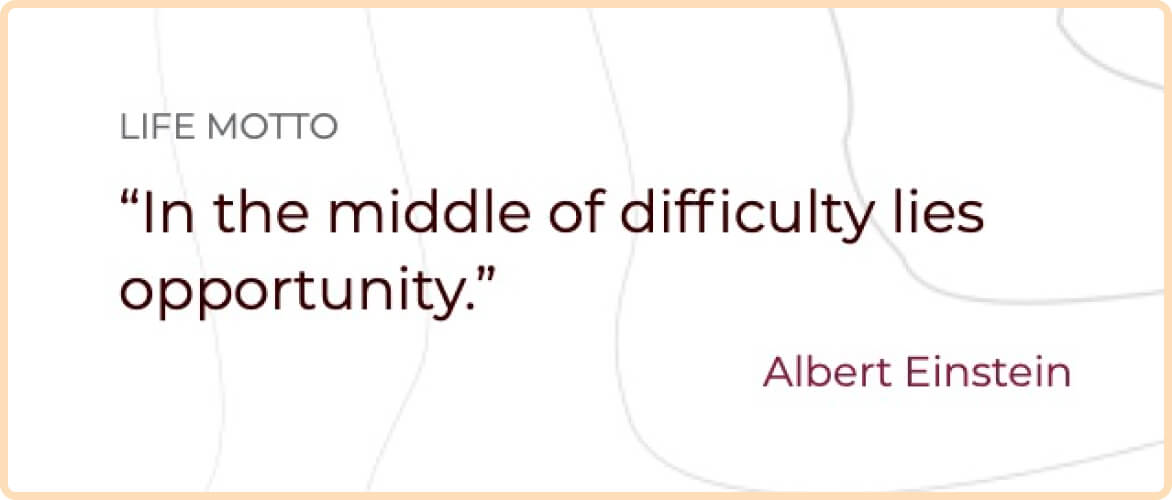
Next, William shared his life motto in a single sentence: “In the middle of difficulty lies opportunity”. A simple quote can speak volumes about you as a person and your attitude to work and life itself.
Beyond showing how you see the world, it signals to companies whether you might fit into their culture. This shows us that William is not the kind of person that gives up. He perceives problems as opportunities.
Taken together, these sections give a brief and quick insight into who William is and the energy he would bring to his role and the team. As opposed to a lengthy personal summary, William said all he needed to in two short sentences. Now, let’s continue with William’s experience section…

William includes 3 jobs within his experience section. These are the most recent and significant jobs that relate to the field he hopes to work in. They’re also quite diverse.
Rather than writing pages on every job he has ever had, he has tailored his experience to three impactful descriptions of the jobs that relate most to the job vacancy.
He also decided to name the section Entrepreneurial Experience . This suggests that it covers only a portion of his work experience. This is a case where careful decision-making really pays off.
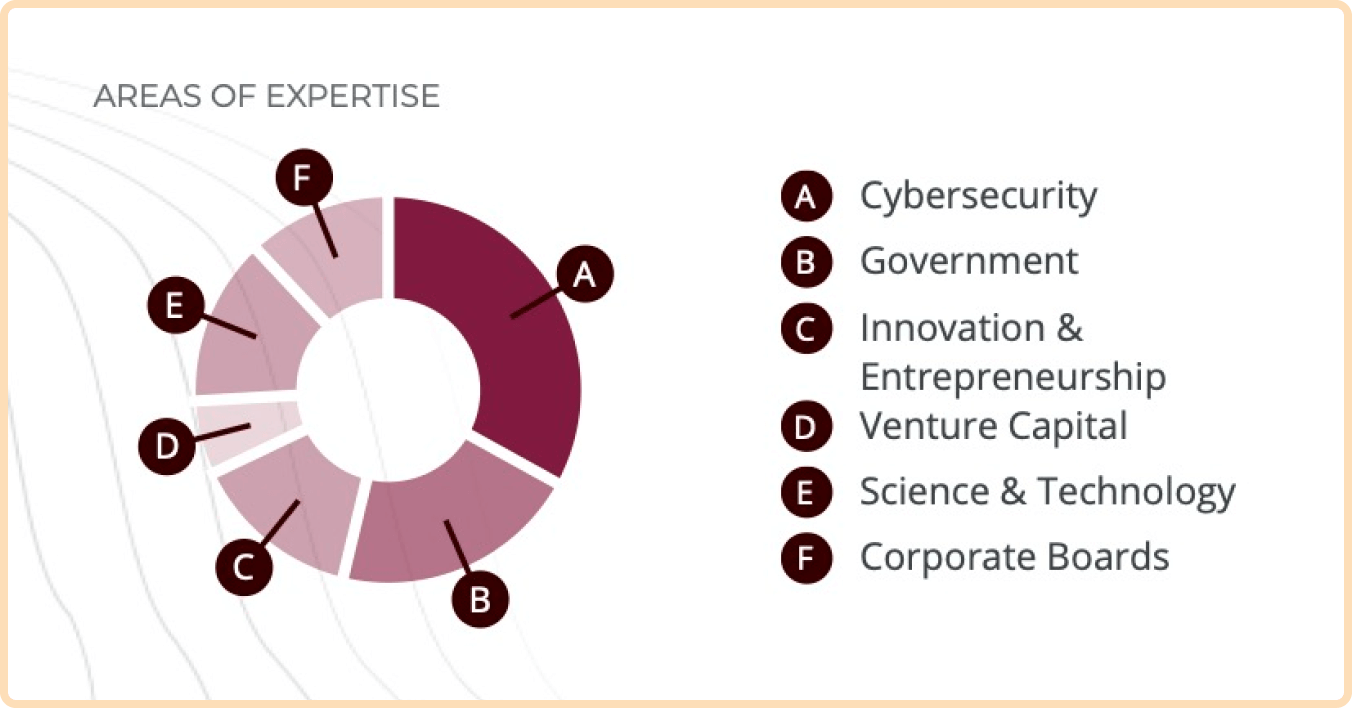
William goes on to make use of an Enhancv exclusive – the “My Time” section. This allows users to show their time spent during the week or a typical day-in-the-life.
For example, the section makes it obvious that Cybersecurity is something he does best. Again, using this quick visual saves a ton of space.
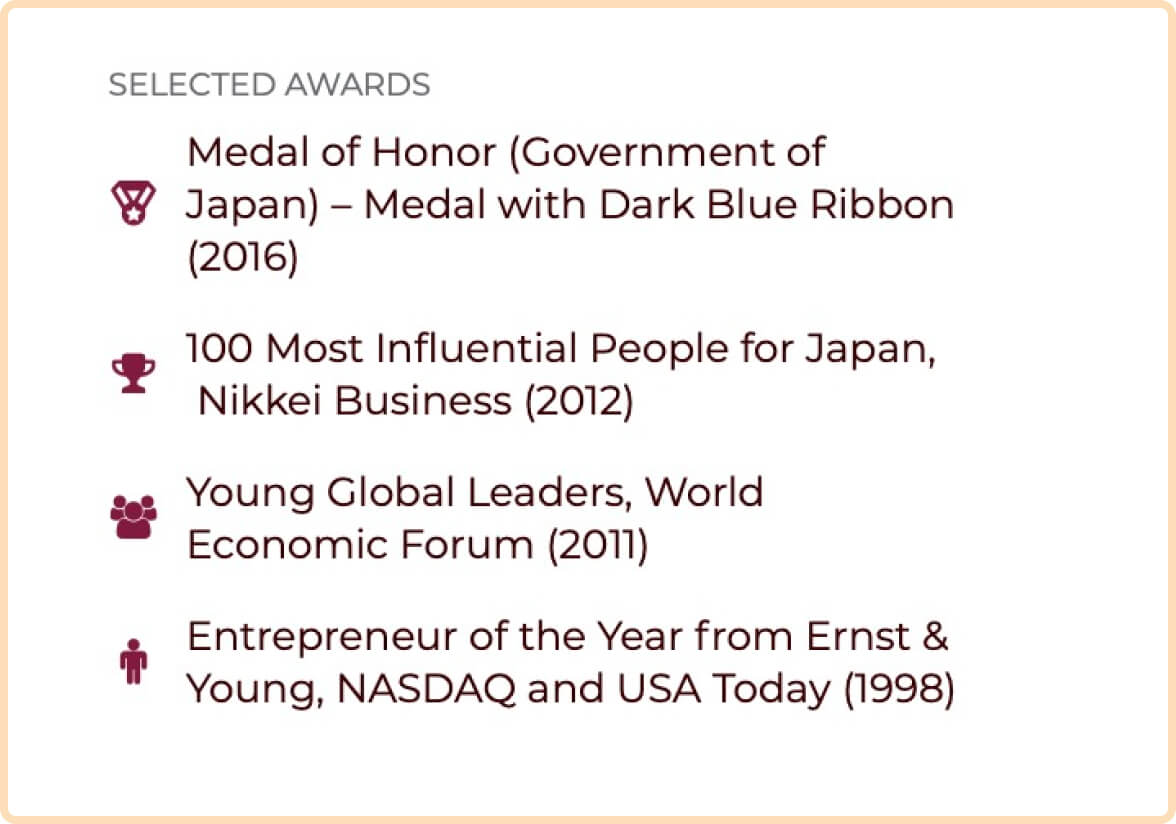
Furthermore, William utilizes an awards section to mention advising the Japanese Government as well as over twenty tech companies regarding business, technology, and security.
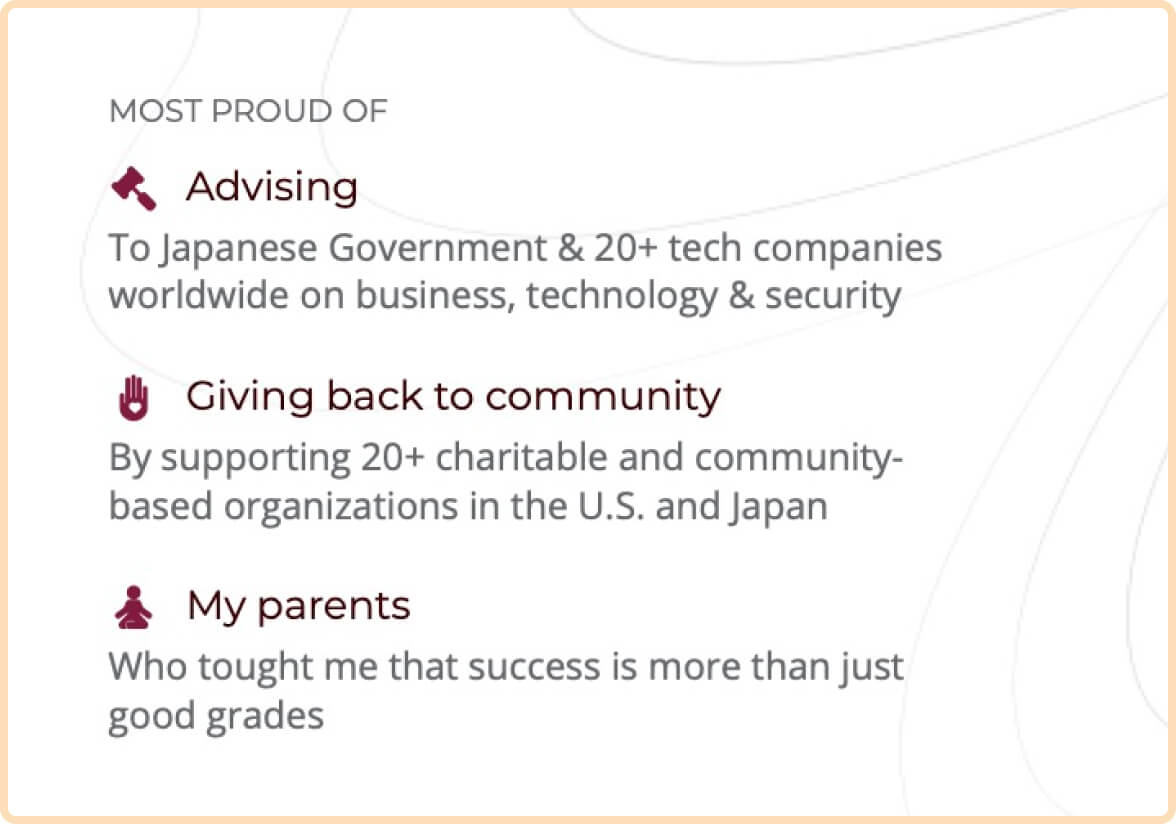
His other point is ‘’Giving back to the community’’, where he mentions that he’s been supporting charitable and community-based organizations. This saved William another page where he listed all his advisory positions and achievements. All in a few sentences, with bits of his character.
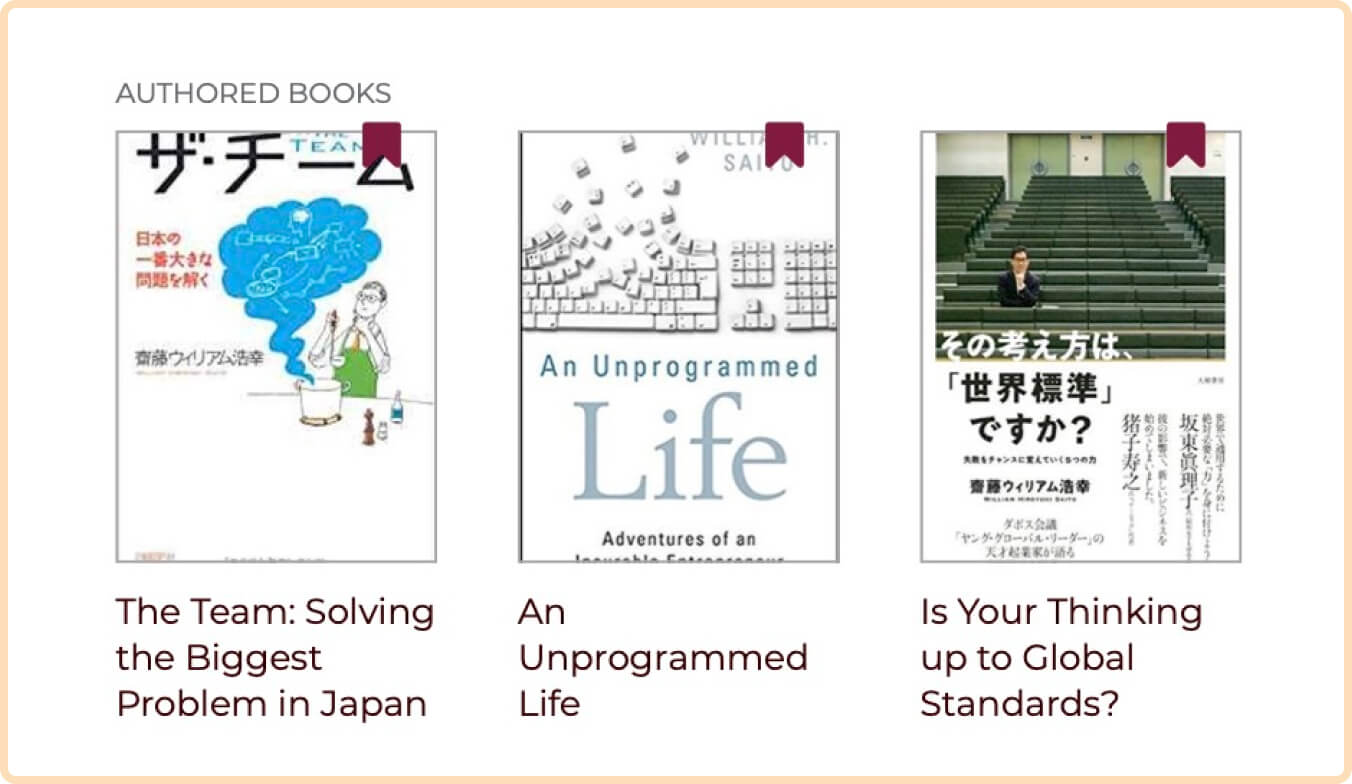
William backs up his previous experience with a notable metric that shows his impact on the bottom line. In a few short words, we see the results of his work. His Authored Books section (another section offered by Enhancv) contributes to this, too. Here, we get a quick visual of the books he’s published, rather than a long description that would take up many paragraphs.
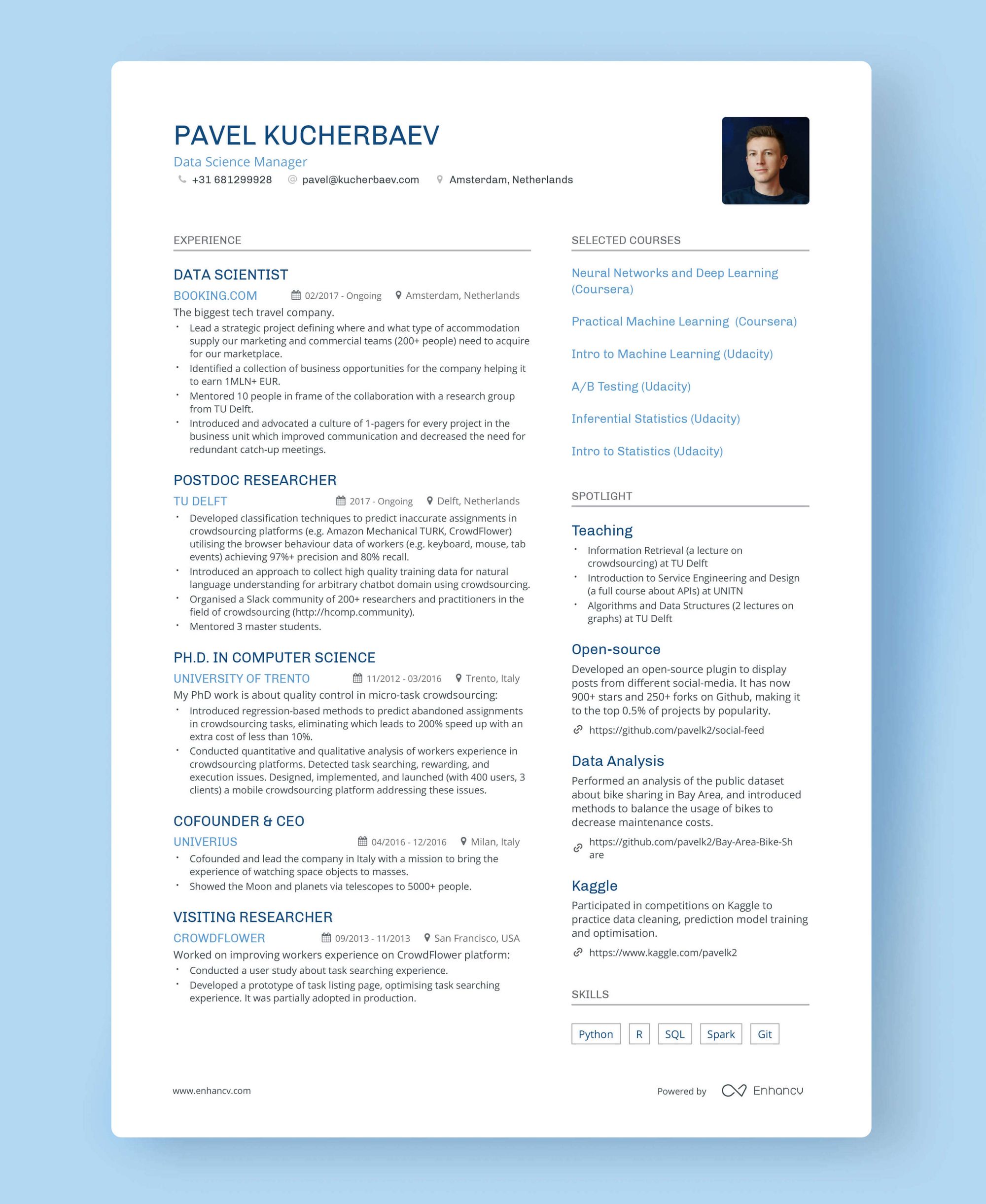
Pavel’s resume is a great example of someone who has taken our modern resume template and made the most of it.
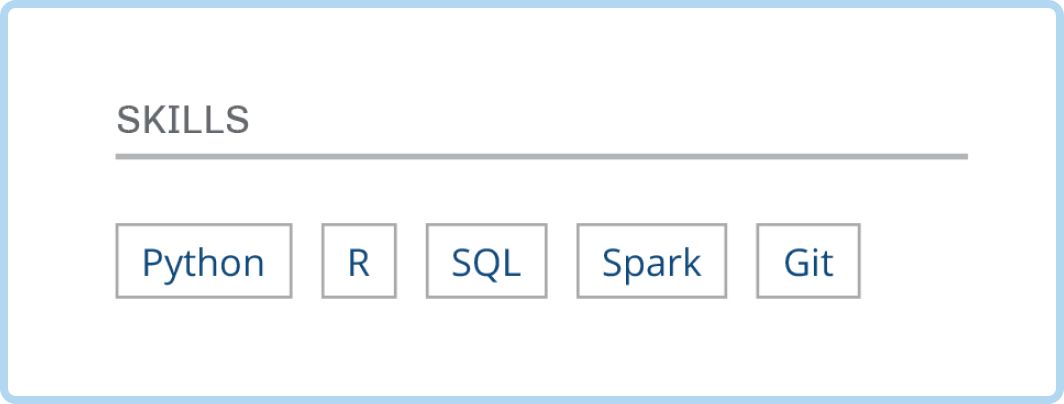
Pavel has utilized the Technology section of our resume builder to give a snapshot of the programs he is familiar with. Here, we see five highlighted technologies. It’s simple but effective. This cuts down on writing full sentences to show what systems you’re comfortable with.

Taking a look at Pavel’s experience section, we can see how job-rich it is. We’re looking at 6 job titles – from a researcher to a co-founder and CEO. Data science is a relatively new and expansive area of tech.
For this reason, it’s beneficial to include as many previous experiences as you can that relate to possible duties. Each job is accompanied by a quick bullet point that explains all of Pavel’s responsibilities, and everything is written concisely.
Much like William, Pavel intertwines his impact with his previous experience by providing a significant metric to measure his achievements.
For example, he showed the moon and stars to 5000+ people.
This short description focuses the recruiter on tangible evidence that does not take up a lot of space. If a recruiter wants to know more, they will ask in an interview or over email.
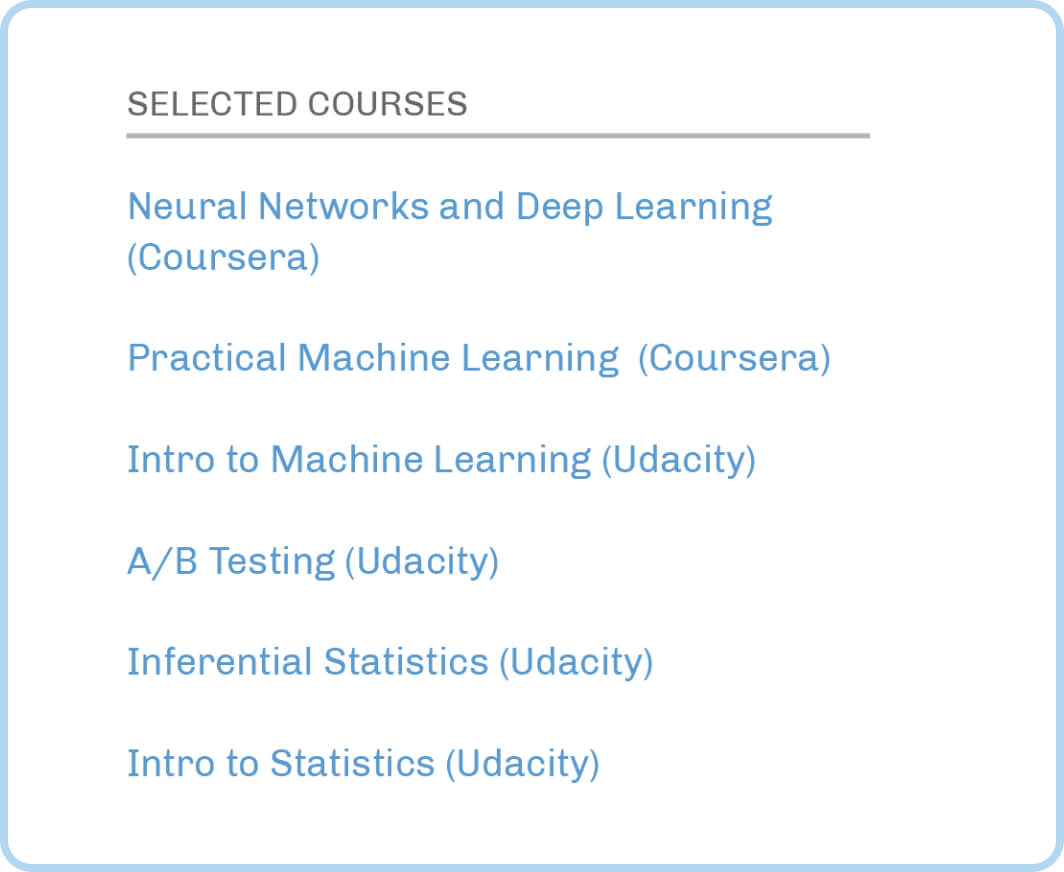
Pavel’s experience is further explained in a simple list of his Selected Courses . Here, space is saved by collecting all relevant and important courses he’s taken in a single section. The titles are enough for the recruiter to understand his skill.
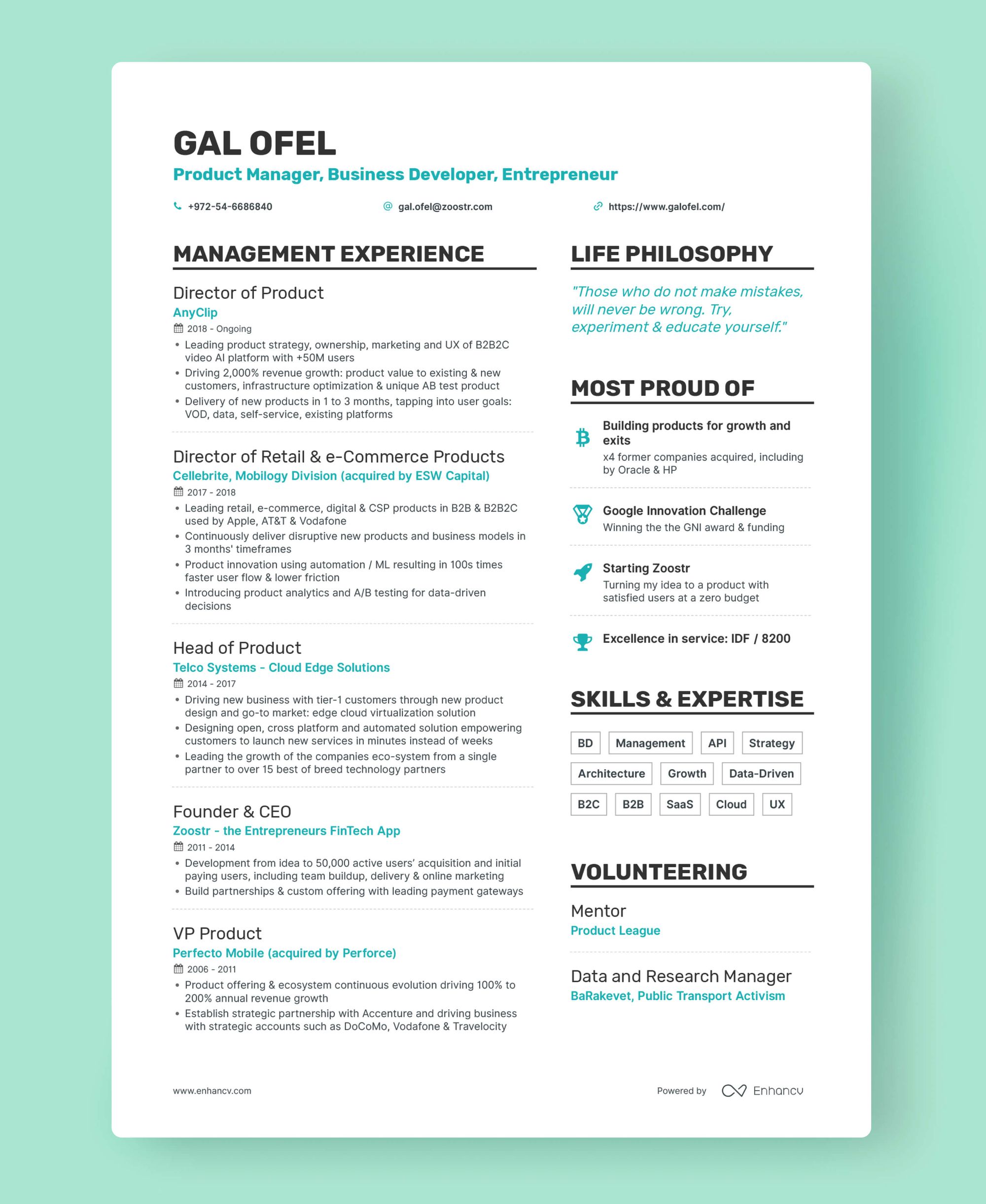
Gal shows us that any resume template can be used when building a one-pager. Using Enhancv’s staple – the double-column resume – Gal makes an impact without drawing things out.

Accomplishing this in two-three sentences will do wonders to signal to companies that you fit within their culture – ultimately getting you an interview sooner.
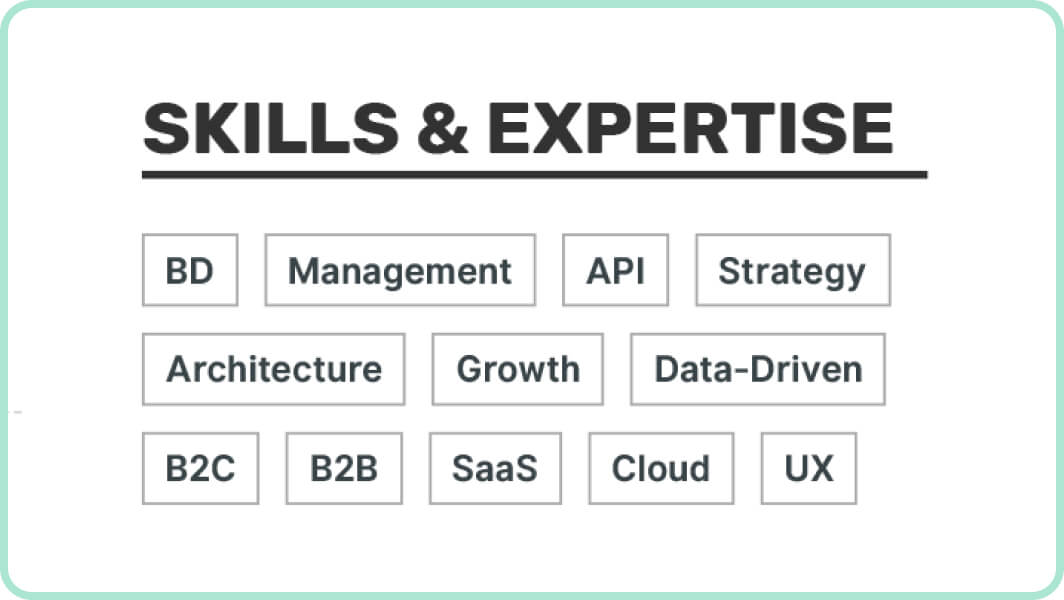
Gal makes use of Enhancv’s technologies section but renames it as an “Expertise” section. With this, the recruiter can easily see that Gal is gifted when it comes to B2B, B2C, SaaS, and more. This is an excellent example of cutting paragraphs down to singular words with the same impact.

Again, Gal introduces his impact by providing a significant metric to measure his achievements. For example, “driving 50% to 100% annual revenue growth”. This captures his ability in one bullet point, as opposed to several sentences on ways he brought a change in a previous company.
Whether you’ve got 25 years, a decade, or a month of experience, making a strong impression is essential. A single-page resume helps you do that.
We gathered the career counseling team at Enhancv and put all their know-how around writing impactful one-page resumes.
Use a double-column or compact resume template.".
A one-pager resume with plenty of experience will not fit on a single-column template. At Enhancv, our double-column template is specifically designed to meet applicant tracking systems requirements and with one-page resumes in mind. You can fit up 50% more information compared to what general resume templates allow for.
Write short, action-oriented bullet points.
Cut the fluff and focus on the make-it-or-break-it moments in your career. Stick to active words and use buzzwords properly .
Draw inspiration from the examples above, or recollect the moments that made you the professional you are today. If you need more inspiration, we have over 500 job-specific resume examples for you to explore and inspire from.
Use smaller fonts.
Choose a smaller font size but make sure the text remains legible. Size 10 or 11 looks fine and passes readability checks, anything smaller would make your resume hard to read.
Fonts like Oswald , Bitter , and Volkhov are more compact and allow you to fit more text on a single page.
Remove unnecessary sections.
When you have a lot of relevant experience, you can skip the Education section. Unless you have Cum Laude from an Ivy League university, you’re generally okay with not including your education. Leave off references as well, unless they’re highly relevant for the job position.
Make sure that your summary is short but packed full of information. It’s the best way to communicate who you are and your skill set in a single sentence.
Decrease the margins' size.
When you decrease the margins of your resumes you get to add more information, however, you have to keep in mind the readability of your resume. No hiring manager wants to read a wall of text.
Enhancv’s resume builder has in-built resume margins you can switch between that still keep your resume readable and easy on the eye.
Use creative sections to spotlight career milestones.
One-page creative resumes are the hardest to make. We’ve compiled over 20 creative resumes for you to check out. You can make your very own by signing up for Enhancv –– or you can hire our career counselors to help you make your resume .
Single-page resumes seem difficult to create until you get the hang of it –– focus only on experience and skills that show how you can make an impact in the company you’re applying at.
- Cut the extra fluff. Choose only the relevant, result-driven information.
- Use different sections to reframe and communicate your experience in short and engaging ways.
- Choose an Enhancv resume template and focus only on the information and not the design.
- Focus on font size and margins to fit as much information as possible.

- Resume Guides
How to Ask for Feedback after an Interview
What jobs should you put on a resume, how to list continuing education on your resume, negotiating a salary increase for a new job: what to expect and how to ask, describe your greatest challenge - interview question (+answers), what is an activities resume for college tips and examples.
- Create Resume
- Terms of Service
- Privacy Policy
- Cookie Preferences
- Resume Examples
- Resume Templates
- AI Resume Builder
- Resume Summary Generator
- Resume Formats
- Resume Checker
- Resume Skills
- How to Write a Resume
- Modern Resume Templates
- Simple Resume Templates
- Cover Letter Builder
- Cover Letter Examples
- Cover Letter Templates
- Cover Letter Formats
- How to Write a Cover Letter
- Cover Letter Guides
- Job Interview Guides
- Job Interview Questions
- Career Resources
- Meet our customers
- Career resources
- English (UK)
- French (FR)
- German (DE)
- Spanish (ES)
- Swedish (SE)
© 2024 . All rights reserved.
Made with love by people who care.
How to get your resume down to one page
You know that recruiters don’t spend much time reviewing resumes, so you want to get yours down to one page.
A great idea, but it can be difficult to execute.
How do you cut the size down without losing important content or making it look messy?
Here are 21 tips to help reduce your resume down to one page, and still ensure you land job interviews.
Resume templates
Formatting tips
When looking to trim down your resume , always start with formatting tips.
Format adjustments to the style of your resume allow you to reduce it’s size without removing any of the content you’ve included.

Reduce page margins
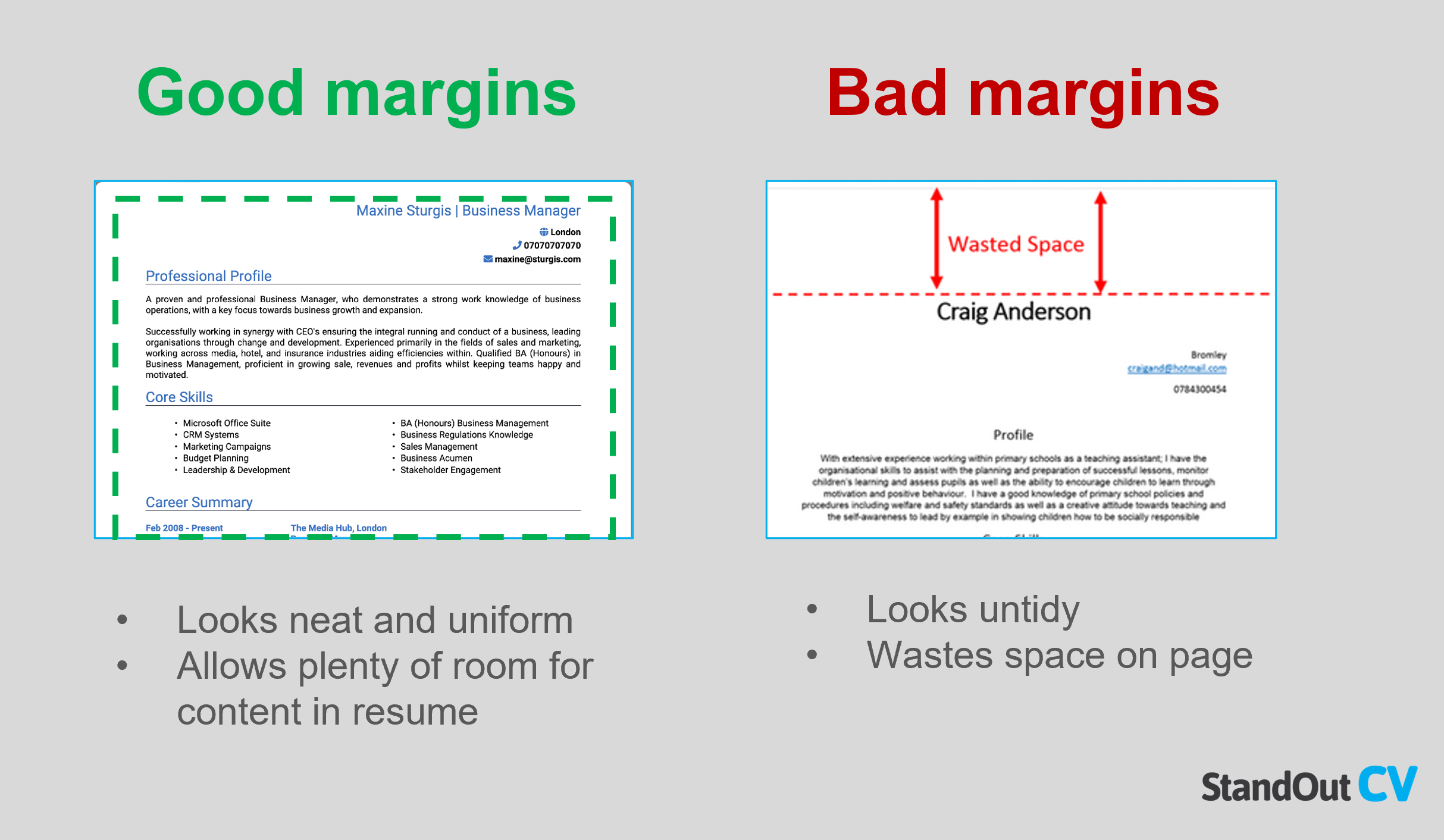
One of the easiest ways to save space on your resume is by reducing the page margins.
Page margins are the space around the outside of the page, between the content and the edge of the document.
You should always leave a small margin to keep the resume looking tidy, but reducing it by a few points will increase the amount of text you can get onto the page.
Here’s how to reduce page margins in Microsoft Word . Click the “Layout” tab, then select “Margins”

Reduce line spacing
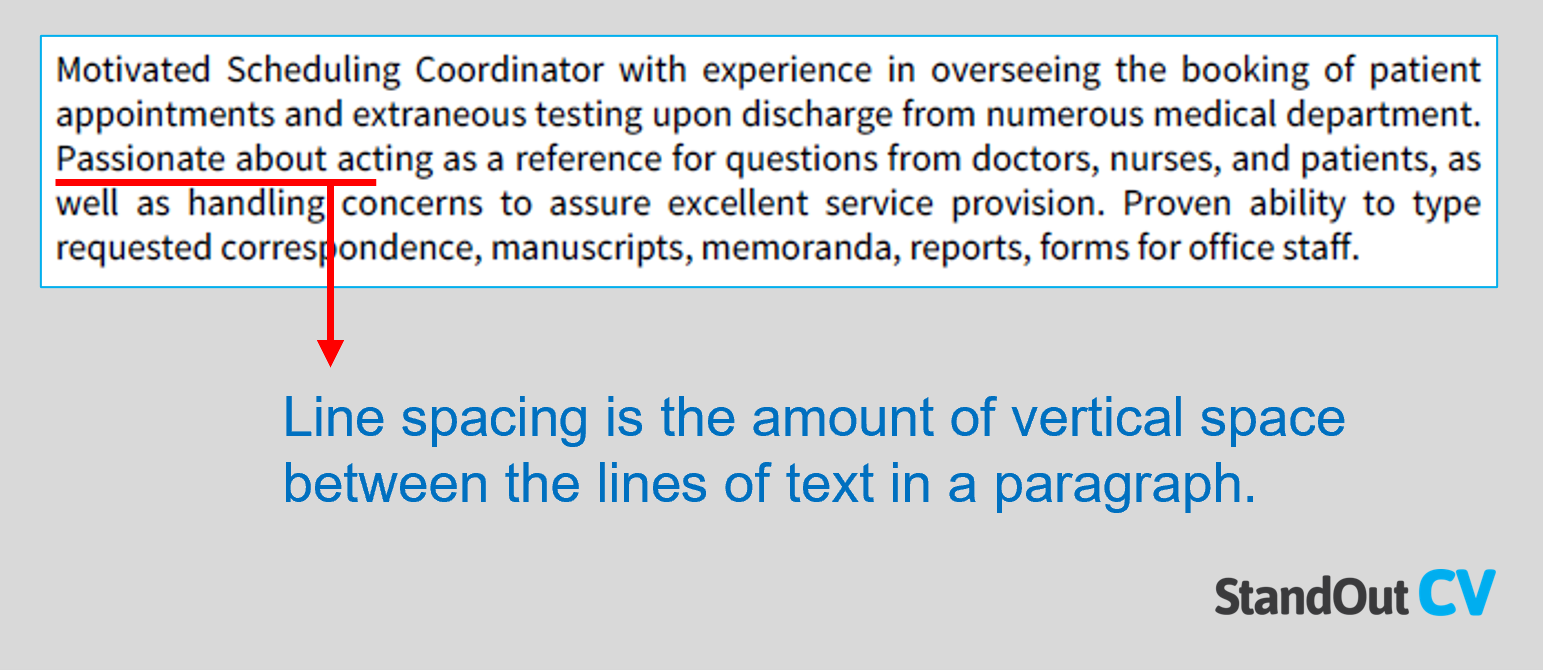
Another way to save space on your resume is to reduce the spacing between lines of text, paragraphs or sections.
This can be done by adjusting the line spacing settings in your word processor. However, be careful not to cram too much text together, as this can make your resume difficult to read.
A line spacing of 1 or 1.15 should be sufficient to strike a balance between space-saving and readability.
Remove photos

While it may be tempting to include a photo on your resume, it’s generally not necessary and can take up valuable space.
Unless you’re applying for a job in the entertainment or fashion industry, most employers won’t be interested in seeing what you look like.
Removing the photo can free up a lot of space in your resume and make it easier to fit everything onto one page.
Remove unnecessary design features
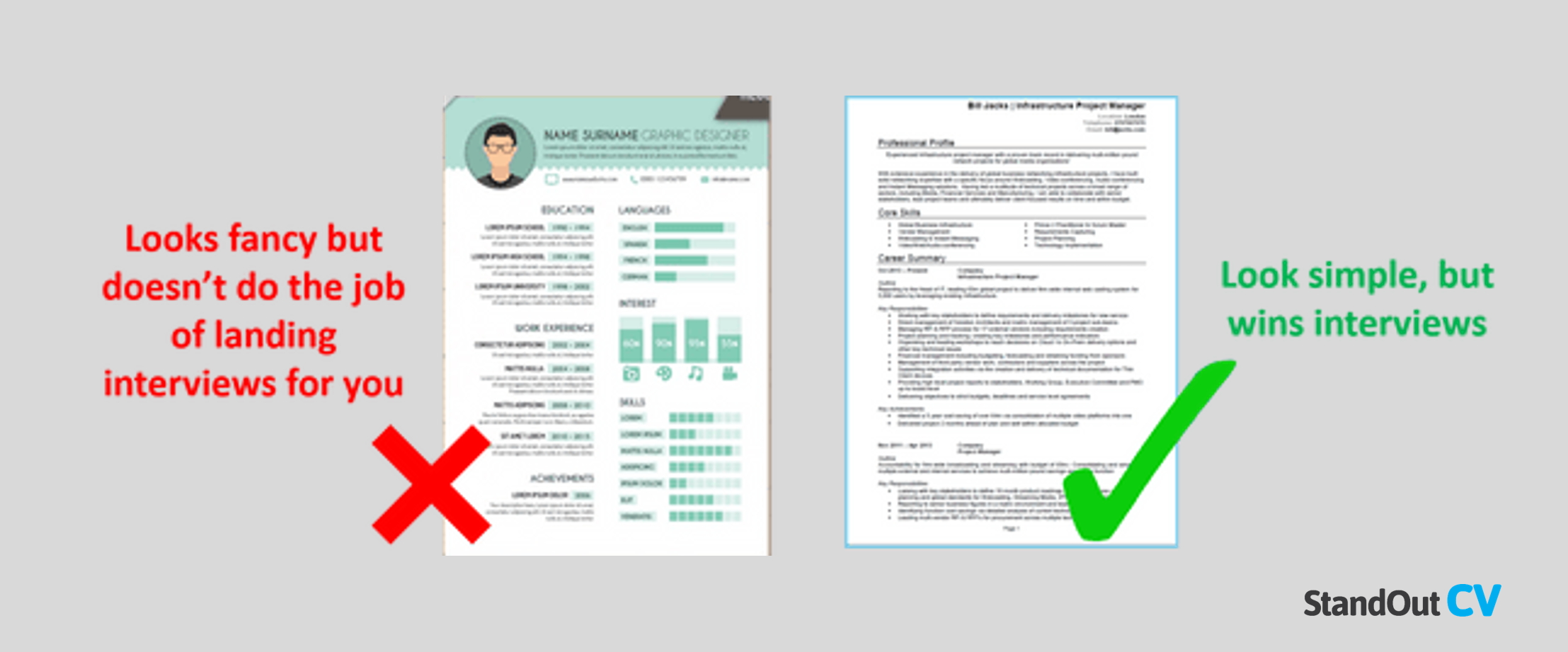
Design features like colored side bars, borders, and icons may look nice, but they can also make your resume more difficult to read and take up valuable space.
When trying to reduce your resume to one page, it’s best to stick with a simple, clean one-column layout. Use bold or italic text to highlight important information, and avoid adding anything that might take up space unnecessarily.
Reduce size of name and contact details

While it’s important to include your name and contact details on your resume, they don’t need to take up tons of space.
Use a smaller font size or reduce the spacing between lines to make these details more compact. Just make sure that your name and contact information are still easy to read and clearly visible.
Also think about the format you are including this information in. For example; does a recruiter really need to see your full address at the top of your resume? Or would it be sufficient to just include your town, to give them a general idea of where you can commute to?
Reduce font size
When trying to fit everything into one page, reducing the font size is an obvious but useful strategy.
But remember it’s important to make sure that the text remains legible for recruiters and hiring managers. A font size of 10 is generally the smallest you should go, and using a clear, simple font like Arial or Calibri can help ensure that your resume remains functional.
However small you choose to go, just make sure it can still be easily read.
Use multiple columns
If you find that you have lots of blank space on the right-hand side of your resume, then using multiple columns can be a helpful strategy.
This can be done by creating a table or using a resume template that includes multiple columns. Just be sure to keep the layout clean and easy to read, and avoid cramming too much information into each column.
One area of your resume where this works especially well is the Core Skills section.
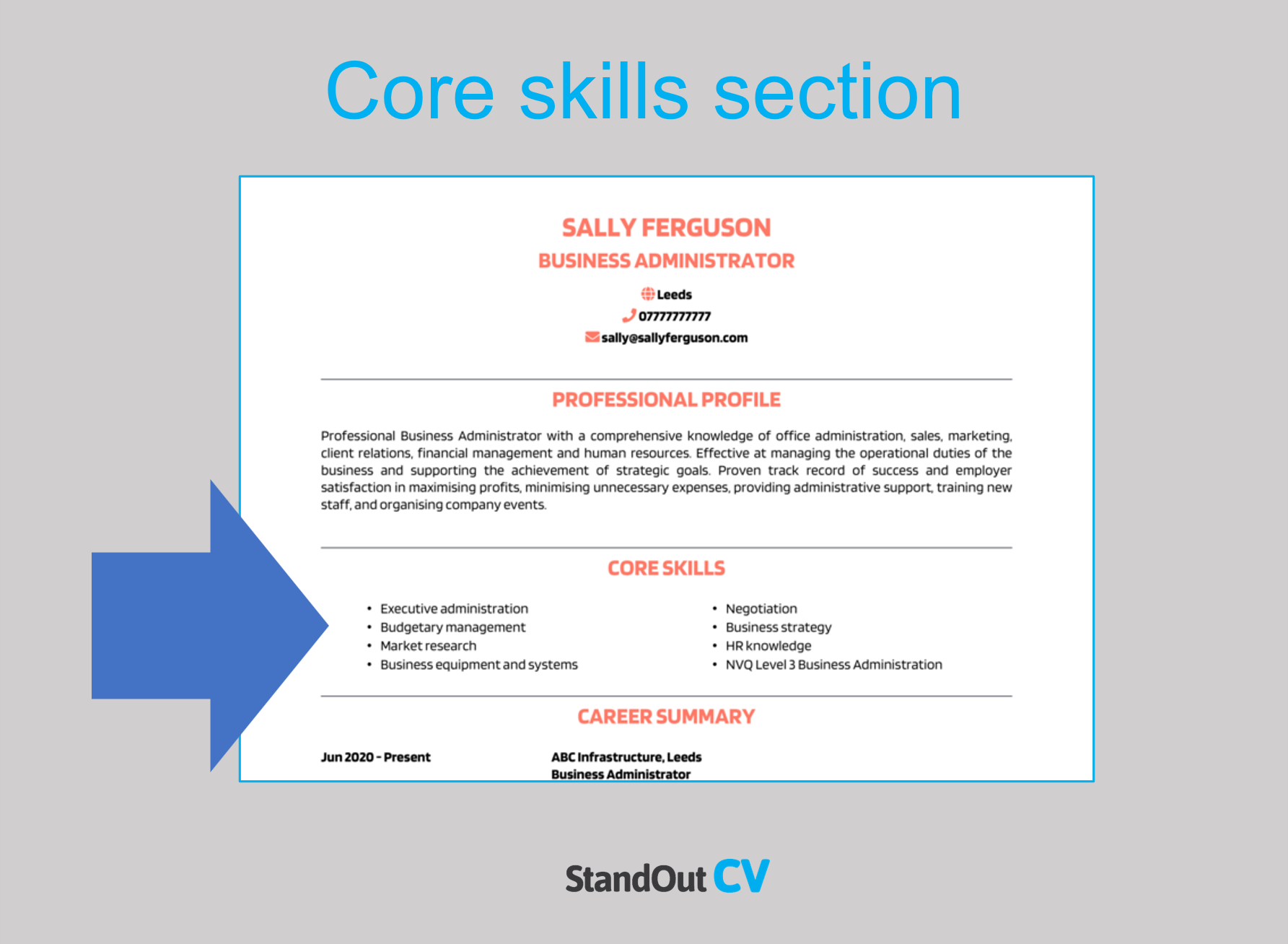
Fill white space
If you find that your resume has large areas of white space anywhere on the page – just fill them.
For example, if you have a big block of unused space in the top-right corner, think about what other content from the resume you could move there.
Perhaps your contact details could be moved into it, or even your core skills.
Just play around with the layout until you find something that works.

Content tips
If you have exhausted all of the above formatting tips, you’ll need to start cutting down on the content.
Here are some tips on how to do so, without removing the important stuff that hiring managers need to see .
Remove very old work experience
If you have a lot of work experience, it’s usually not necessary to include it all on your resume.
Definitely remove work experience that is more than 10 years old, and consider removing anything 5 years older if you are really struggling for space. This will help keep your resume focused because hiring managers will mainly be interested in your recent work, as a way of gauging your current abilities.
Summarize old roles

If you do decide to include older work experience, consider summarizing it rather than providing a detailed description with lots of bullet points .
For example, instead of listing every job duty you had 15 years ago, you could simply state the job title, company, and provide a one sentence overview.
Group multiple roles into a batch
If you’ve had multiple roles within the same company (or even industry) consider grouping them together under a single heading. This can help save space on your resume and make it easier to read for time-strapped recruiters.
For example, you could list your job title as “ Marketing Manager / Marketing executive (2010-2016) ” and then provide a brief description of your responsibilities and promotions during that time.
Or you could write something like “ Various banking project manager roles – 2001-2007 ”
Write more succinctly
When it comes to writing your resume, less is often more. Be sure to use clear and concise language, and avoid rambling or including unnecessary information.
Review your sentences and remove words or details that aren’t necessary to tell your story.
Use digits instead of written numbers
To save space on your resume, consider using digits instead of written numbers wherever possible.
For example, you could write “increased sales by 25%” instead of “increased sales by twenty-five percent.” This will help keep your resume focused and concise.
Reduce personal information
While it’s important to include your contact information on your resume (cell number and email address) you don’t need to include personal details like your marital status, age, or race.
This information is not relevant to your ability to carry out the job, and recruiters do not need to see it on your resume.
Make use of links
If you have an online portfolio or personal website that showcases your work, try including a link to it on your resume.
This can provide lots of additional proof of your skills and knowledge for recruiters to look at, and will only take a few characters of space on the page.
Remove mentions of references
Employers cannot ask to contact your references until after they have interviewed you and made you a formal job offer.
This means that there is no need to put any reference details on your resume, or even state that “reference are available on request”
If you have any mention of references on your resume, removing them is a quick and easy way of saving space.
Reduce the size of your summary
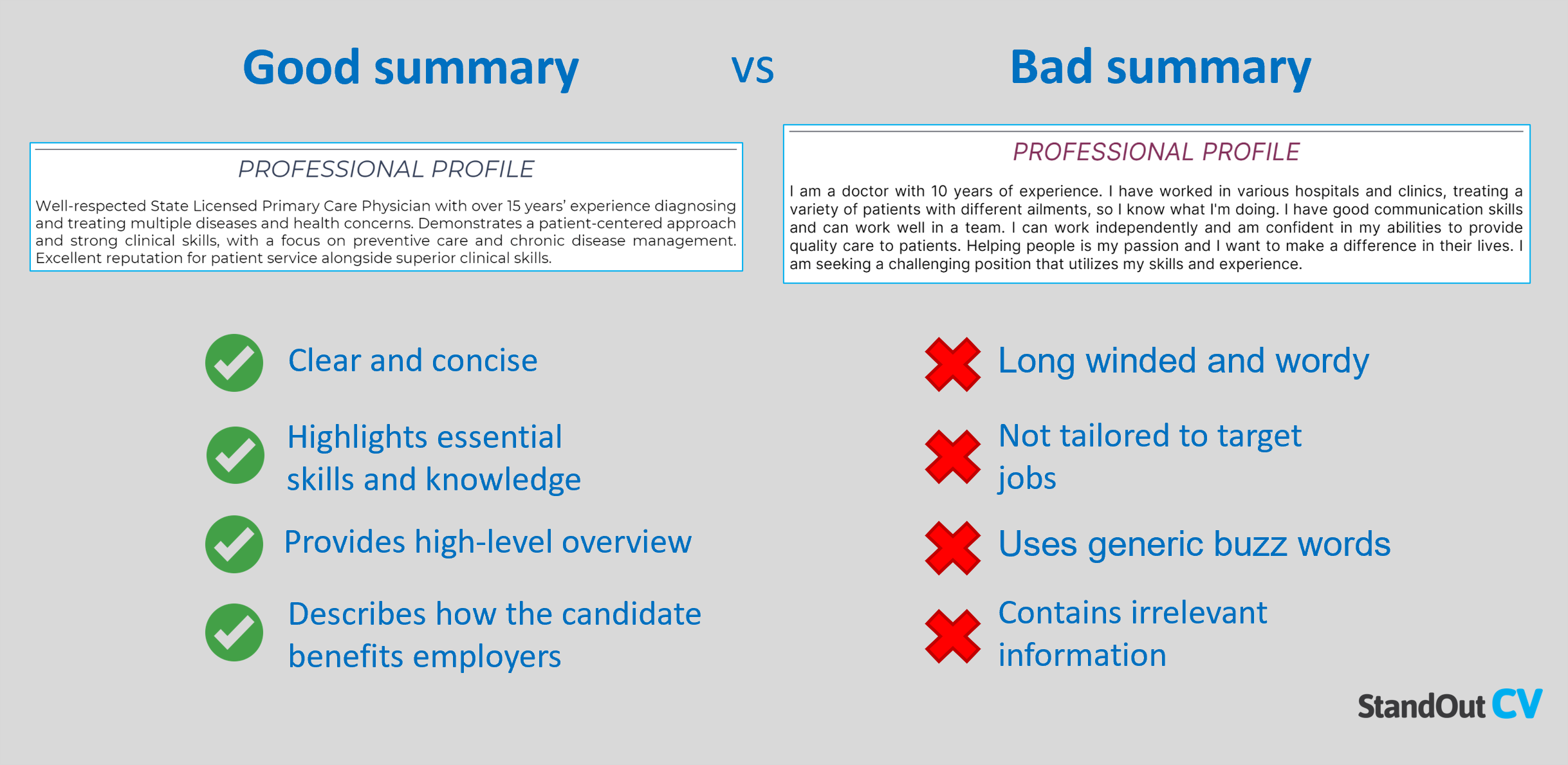
If you have a summary or objective statement at the top of your resume, it should not be longer than 4-6 sentences.
If it is, you need to cut it down.
Your summary is intended to be a high-level overview of your skills and experience, so keep it brief and save the detail for your work experience section.
Remove hobbies and interests
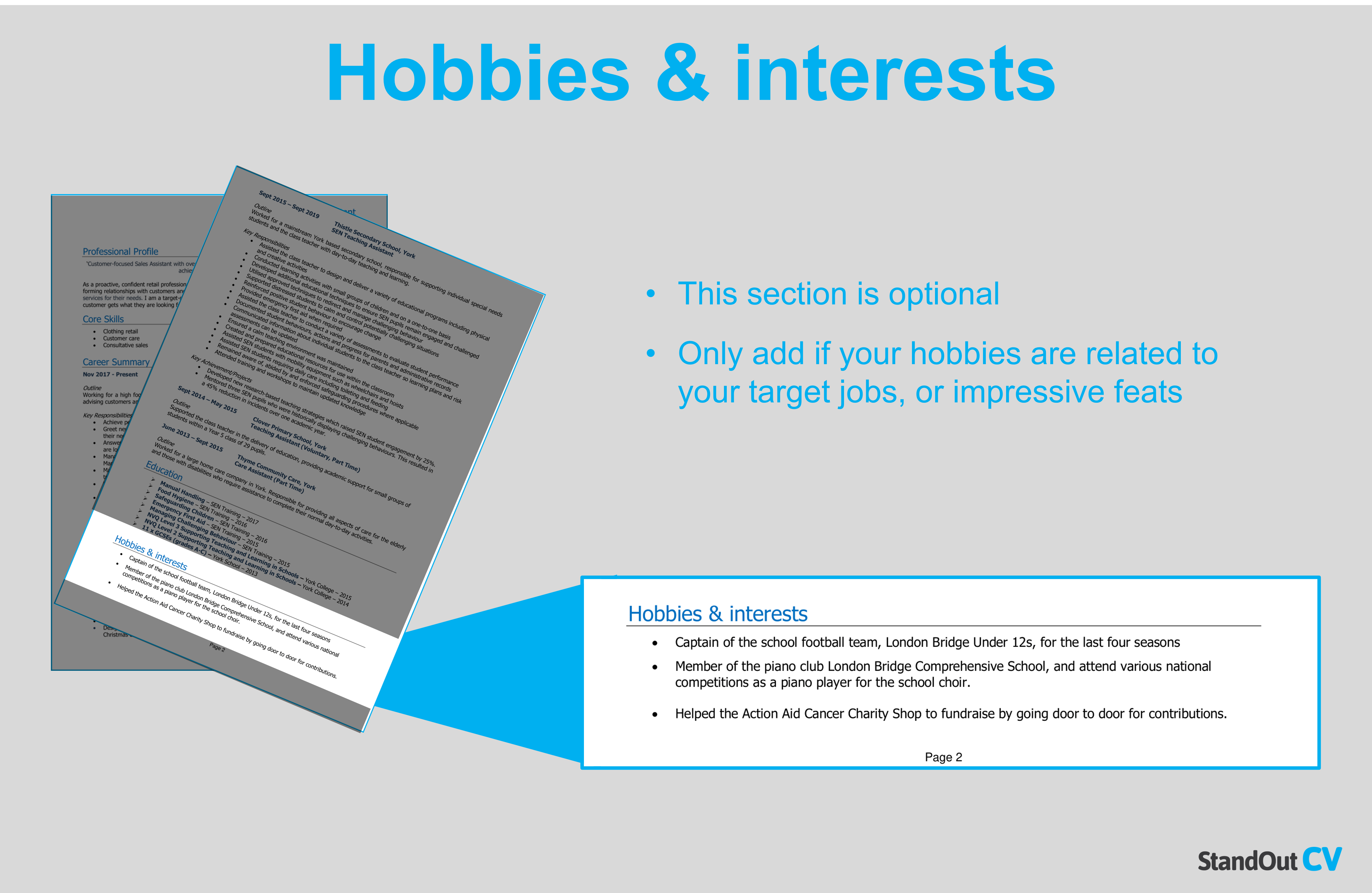
Hobbies and interests do not normally have any impact on a hiring decision.
Unless you have a specific hobby or interest that’s directly related to the job (for example, if you’re applying for a job in the fitness industry and you’re an avid runner), it’s best to leave this information off when shooting for a one-page resume.
Remove non-vital certifications
If you have a lot of certifications, consider removing those that aren’t essential to the job you’re applying for.
For example if you are applying for legal jobs then it will be imperative to keep your law degree in the resume – but you can probably remove your high school grades and first-aid certificate.
This will help keep your resume focused and prevent the education section from becoming too long.
Use acronyms
Using acronyms can be a great way to save space on your resume, especially when it comes to technical terms or industry-specific jargon.
For example, instead of writing out “Search Engine Optimization,” you could simply write “SEO.” Just be sure to use acronyms that are widely recognized and understood within your industry.
Tailor your resume heavily
One of the most important things you can do to reduce your resume to one page is to tailor it heavily to the job you’re applying for.
This means cutting out anything that is not relevant to match the requirements of the positions you are applying for.
If you are really struggling to get size down to one page, you can be really brutal here.
Use keywords from the job posting, and make sure that your resume only highlights the skills and experience that are most relevant to the job.
This will also help ensure that your resume stands out to employers and increases your chances of landing an interview.
Does your resume need to be one page?
Although one page resumes have their advantages, your resume doesn’t necessarily need to be one page.
The length of your resume will depend on your individual circumstances and the expectations of the industry you’re applying to.
For example, if you’re a recent college graduate with limited work experience, a one-page resume may be appropriate. However, if you have extensive experience or a long list of accomplishments, a two-page resume may be more suitable – and won’t necessarily offend recruiters.
That being said, it’s important to keep in mind that employers are often pressed for time and may not have the bandwidth to review lengthy resumes.
It’s generally a good idea to keep your resume as concise and focused as possible, highlighting only the most important information and accomplishments.
Ultimately, the goal is to create a strong and compelling resume that effectively communicates your skills, experience, and qualifications – and this can be done effectively with one or two pages.
Pros of a one page resume
- Easy for recruiters to read – A one page resume can be quickly and easily reviewed by employers, saving them time and increasing your chances of making it past the initial screening process .
- Focus on important attributes – A concise and focused one page resume can highlight your most relevant skills and experience quickly, helping you stand out as a strong candidate for the job.
- Show off communication skills – A one page resume can demonstrate your ability to communicate effectively and efficiently, which is an important skill in many industries.
Cons of a one page resume
- Not enough detail – A one page resume may not provide enough space to fully showcase your qualifications and experience – particularly if you have extensive work history or a complect profession.
- Not always industry suitable – A one page resume may not be appropriate for certain industries or positions, where a more detailed and comprehensive resume may be expected ,such as technical or scientific roles.
- Knowledge Base
- Free Resume Templates
- Resume Builder
- Resume Examples
- Free Resume Review
Click here to directly go to the complete one page resume sample.
Should a resume be one page?
One page resume is easy for hiring managers to scan over quickly.
It is not overwhelming, and with the right guidance, can contain a lot of valuable information.
Are you looking for crisp one page resume examples that get you those shortlists for interviews?
Read on to know the perfect one page resume template for your job profile . Look out for some special tips and tricks here and there!
Table of Contents
- What is a One Page Resume?
- Who Should Have a Two Page Resume?
- How Do You Write a One Page Resume?
- How Do You Format a One Page Resume?
What Are Called One Page Resume Templates?
Most of the time, a short and crisp resume is the best choice .
Your resume does not need to contain lots of depth about your past jobs and abilities. A resume and a cover letter are just a quick snapshot that opens the door for further discussions; hence one page resume is the best option. In your interview, the employer may ask for more details from a job seeker.
Only send a longer document if it’s mentioned in the job description (like a C.V. for academic jobs).
Also Read: How to write a resume?
One Page vs. Two Page Resume Templates
If you wonder how to make one page resume template or should a resume be one page, then fret not! We got you covered.
Make a one page resume if:
- Your job profile is in a conservative field
- You have less than ten years of job experience
A two-page resume isn't ideal for applying to any job unless there is a requirement.
Make a two page resume if:
- You have a significant amount of relevant work experience
- You are making a senior-level resume (10+ years of professional experience)
- The JD asks for your entire work history
Sample One Page Resume Templates
Here are some of the one page resume examples for your reference.
Material Color one page resume template
- Marketing Manager & Senior Sales Professional

Simple Black One Page Resume Template

Traditional Maroon One Page Resume Template

Round Timeline One Page Resume Template

Signature Timeline One Page Resume Template

Boxed Navy One Page Resume Template

Orange Twist One Page Resume Template

Gradient Green One Page Resume Template

Trendy One Page Resume Template

Modern Teal One Page Resume Template
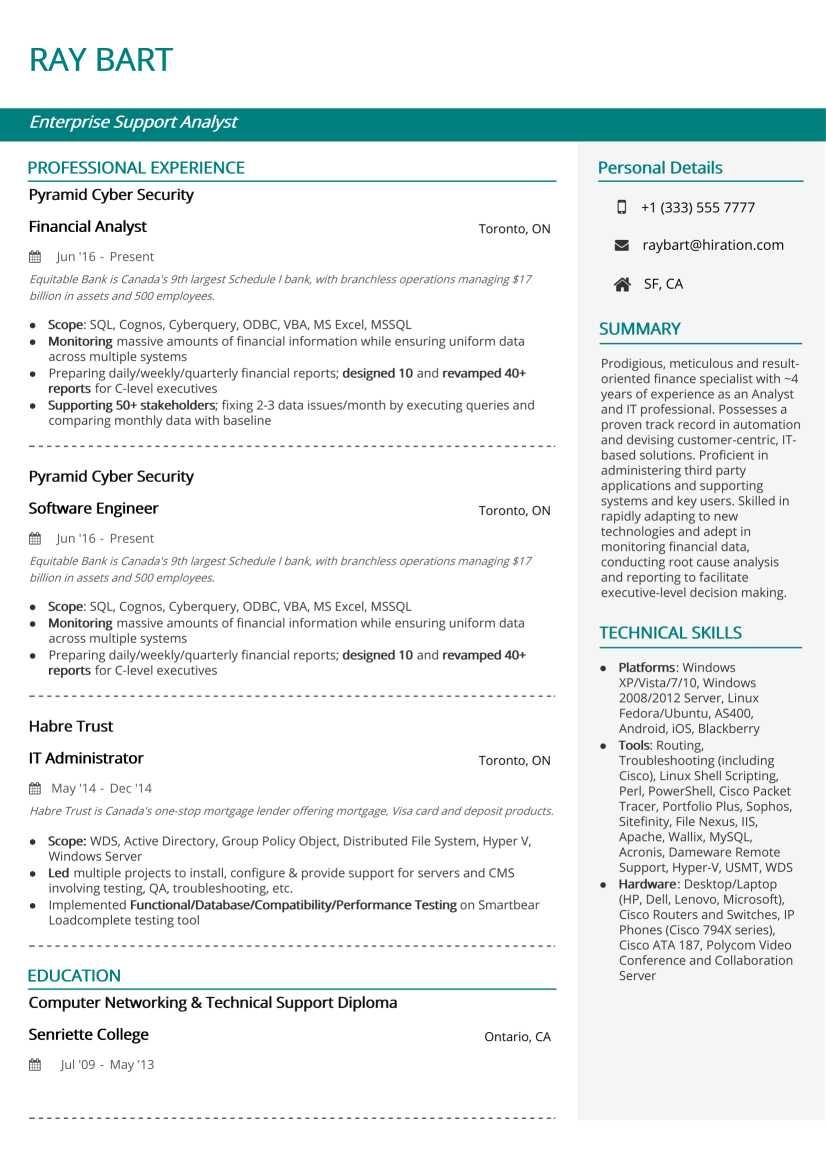
Uniform Brown One Page Resume Template

Global Citizen Red One Page Resume Template

Professional Blue One Page Resume Template

California One Page Resume Template

New York One Page Resume Template

Royal Blue One Page Resume Template

Diamond Timeline One Page Resume Template

Global Citizen Green One Page Resume Template

Professional Black One Page Resume Template

Do Read: How long should a resume be?
How to Make a Resume One Page?
Students and professionals both have a lot of qualifications to add to resumes today. They have awards, certifications, projects, skills, etc.
But with this massive amount of experience, it’s difficult to write everything in a one page resume.
But here are some tips to answer your question “how to make resume one page.”
Shorten Resume Margin
The first thing you should do to fit your resume into one page is reduced resume margin. Ideally, the resume margin should be 1 inch on all sides. But if needed, you can reduce the resume margin to 0.5 inches on all sides. But not less than that.
Use Different Resume Formats
You can use double-column resume format to include more information on one page.
Use Smaller Fonts
Another easy way to create a one page resume is by using a smaller font.
Most resumes are written in 12 point font. But you can use a 10 point resume font which is perfectly acceptable in a professional setting. It also reduces the size of the resume.
Avoid Adding Unnecessary Information
Do not include unnecessary information in your resume, such as your hobbies, references, date of birth, irrelevant professional experience, etc.
Use Bullet Points
Do not write the resume in paragraphs. Instead, use short bullet points. It significantly reduces the resume size and helps you fit your experience into one page.
Also Read: Best way to email a resume to recruiter
One Page Resume Template Format
Here's how we should go about a one page resume template:
Summary/Objective : This should be the top section of your resume. Go for an objective instead of a summary only if you are a fresher.
Key Skills : Club all your key skills in this section as per your profile and the job posting of the role you are applying for.
Professional Experience : Jot down all your relevant work experiences. Make sure to list down your latest and relevant experiences only, to save space for other information.
Projects : If you've worked on projects which highlight your professional accomplishments, do mention them.
Internship : If you are applying for an entry-level role or are a fresher, you can mention your relevant internship experiences too.
Certifications/Training : Must leave some space at the end to jot down relevant certifications and training experiences.
Education : Ideally, this should be the last section of your one page resume template and you should list all your relevant qualifications here.
Does a resume need to be one page? Absolutely! Recruiters only give 7 seconds to review a resume. So, you need to make sure your resume is conscious enough so that recruiters don’t have to spend more time on it to get everything.
If you want to squeeze your experiences into one page, you can totally do it. You just have to get selective on the information you are adding to the resume.
Go to Hiration career platform which has 24/7 chat support and get professional assistance with all your job & career-related queries.
You can also write to us at [email protected] and we will make sure to reach out to you as soon as possible.

Share this blog
Subscribe to Free Resume Writing Blog by Hiration
Get the latest posts delivered right to your inbox
Stay up to date! Get all the latest & greatest posts delivered straight to your inbox
Is Your Resume ATS Friendly To Get Shortlisted?
Upload your resume for a free expert review.

- EXPLORE Random Article
How to Keep Your Resume to One Page
Last Updated: January 31, 2023
This article was co-authored by Kent Lee and by wikiHow staff writer, Jennifer Mueller, JD . Kent Lee is a Career and Executive Coach and the Founder of the Perfect Resume, a career development services company based in Phoenix, Arizona. Kent specializes in creating customized resumes, LinkedIn profiles, cover letters, and thank you letters. Kent has over 15 years of career coaching and consulting experience. Previously, he has worked as a Career Consultant for Yahoo and has worked with thousands of clients including Fortune 500 executives from around the world. His work and career advice have been featured in ABC, NBC, CBS, Yahoo, Career Builder, and Monster.com. This article has been viewed 38,058 times.
While a longer resume may be merited if you're applying for an executive-level position or have 20+ years of experience, for most people a one-page resume is sufficient. Any longer than that and you run the risk that the hiring manager won't read the whole thing. If your resume is longer than a page, it's likely bloated with information that you don't need. Keep your resume to one page by tailoring it to the job you're applying for, then editing that content so that it's actionable, direct, and specific. If after that your resume is still more than a page long, try adjusting the formatting to see if you can get it to fit. [1] X Research source
Tailoring Your Resume to the Job

- For example, suppose you're a recent graduate applying for a full-time job as a financial analyst. While in school, you worked as a parking attendant. However, since your work as a parking attendant is not relevant to the work you would do as a financial analyst, you can leave it out.
- Some part-time jobs may have relevance, even if they aren't in the same industry. Think about your job experiences critically. For example, if you're applying for a job as a veterinary technician, it might be relevant that you worked as a pet groomer or pet sitter.
- Your resume essentially markets you to the potential employer and shows them why you are a strong candidate for the job. You don't need to include anything that doesn't add to that message.
Tip: If you have a varied educational or professional background, it can be helpful to create a "master resume" that includes everything. Then you can simply copy and paste from the master to quickly create a resume tailored to a particular job.

- Hard skills include certification or demonstrated proficiency in computer programming or operation, the ability to speak languages other than your first language, and office skills such as typing speed. Do not include soft skills, such as "leadership" or "team player." Instead, show these qualities through the description of your accomplishments.
- It can be tempting to list hard skills you don't actually have. Be careful with this because it may come back to haunt you. Assume that, if hired, you will be asked to do anything included in the job listing as part of your job.
Tip: When listing hard skills, use the same terminology the employer used in their job listing. Many employers use computer software to scan resumes for keywords, and mirroring their terminology can put your resume on the top of the pile.

- For example, if you're applying for a job as a veterinary technician, you would definitely want to include information about volunteering at your local animal shelter, zoo, or nature center.
- If you have the space, you can leave in significant volunteer work even if it doesn't directly relate to the job you're applying for. This is a good idea if you've researched the employer and know they support particular causes related to your volunteer work.

- If an employer does require references, you can often include them on a separate piece of paper, rather than including them on your resume.
Tip: As with creating a master resume, it's also helpful to have a master list of references. That way you can make sure you're offering references that will provide each potential employer with information about you that's most relevant to the job.

- For example, if you play a sport in a community amateur league, you might want to keep that information on your resume if you're applying for a job as a sports writer.
- If you really need the space, you might include them as a line under your work experience section. Change the section heading to "Experience" rather than "Work Experience."
- Through your research, you may have discovered that you and the hiring manager have various hobbies or interests in common. In that situation, it's tempting to leave them on your resume. However, it's better to save them for the interview when you can strike up a conversation about your mutual interests.

- If the degree isn't required for the job, you can leave it off entirely. For example, if the job listing states that a bachelor's degree is required, you would need to include your bachelor's degree on your resume even if it was in a field of study unrelated to the job. However, if you had a higher degree, you could safely leave the bachelor's degree off to save some space.
- If you have a bachelor's degree, you don't need to include your high school education. The potential employer will realize that you have a high school diploma if you have a bachelor's degree. However, you may want to leave it on if you went to an elite high school and you learned through research that the hiring manager graduated from the same school.
Editing Your Content

- Depending on the length of this section, removing it could give you an extra 3 to 5 lines that you can use for valuable content that sells your experience and value to the potential employer.

- For example, suppose in one of your previous jobs you created a training course called "Negotiation Tactics." You're now applying for a new position that requires extensive negotiation, and you want to highlight your expertise in that area as well as your leadership skills. You could write: Created "Negotiation Tactics" course; 10 sales executives increased sales by 25%.
- Specific numbers draw the eye as a potential employer scans your resume and don't take up a lot of space. For example, "Drafted 24 trial briefs" gives your potential employer far more information than simply saying that you drafted documents for senior attorneys. If you round or estimate, include a word such as "around" or "about" so the potential employer doesn't get the impression you're using an exact figure.

- For example, if you have a retail sales position listed on your resume, you might have a bullet point for responsibilities related to customer service and another for sales goals. If you had managerial responsibilities, you would likely have a third bullet point discussing your performance as a manager.
- Read your bullet points aloud and note where you repeat words. For example, "Designed customer service training program to train coworkers to provide better customer service" could be shortened to simply "Designed customer service training program; satisfaction rating increased 18%."
Tip: Generally, avoid having more than 3 or 4 bullet points per item. You don't need the same number of bullet points for each item on your resume – for some items, you may have more to say than for others, and that's to be expected.

- Start bullet points with an action verb. Then, write a brief description of your action or responsibility. Place a semi-colon after that phrase, then include a brief description of the outcome of that action. For example, instead of writing "developed and implemented an email campaign that increased sales by 10% in 1 month," you could write "developed/implemented email campaign; increased sales 10% in 1 month."
- You can often use punctuation instead of conjunctions, which will cut a few characters. For example, instead of writing "designed and conducted training program" you can write "designed/conducted training program."

- For example, instead of talking about "point-of-sale transactions," you can use "POS transactions." The potential employer will likely understand what this abbreviation means, particularly if you're applying for a job in the retail sector.
- At the same time, avoid filling your resume with a lot of industry jargon that has a loose meaning. It can make you look as though you aren't actually that knowledgeable and are simply throwing together industry buzzwords.

- For example, instead of writing "Successfully trained 10 employees on new computer system," you might write "Implemented training program; increased productivity by 38%."
Adjusting Your Formatting

- Make all the text in your resume the same size, rather than having the names of employers or schools larger than the rest of the text.
- If the labels or headings for the sections of your resume are larger than the rest of your text, you can also experiment with making them smaller. Try making them the same size as everything else.
Tip: Use bold and italics to make headings and other important information stand out from the rest of the text. Just keep your usage consistent throughout the entire document.

- Decrease line spacing by the smallest increment possible. Make sure your words don't overlap and can still be read. You may want to print out your resume and see how it looks.

- Particularly if you're emailing your resume, there's a good chance your resume will never be printed on paper. However, you still want to make sure it's printable if necessary.

- If you want to use multiple columns, you're better off starting a new document rather than simply converting the document you have. You'll have an easier time arranging your information correctly.
Tip: While it's not common, you could also try using landscape orientation. It works especially well with multiple columns and can help your resume stand out. However, this approach probably isn't advisable in more traditional fields, such as medicine, law, or finance.
Expert Q&A

- Once you've finalized your resume, convert it to a PDF to preserve your formatting. That way, you can email it to the potential employer without worrying about your formatting getting ruined. Include your full name in the filename for the PDF. Thanks Helpful 0 Not Helpful 0
You Might Also Like

- ↑ https://www.themuse.com/advice/6-pro-tips-for-cutting-your-resume-down-to-one-page
- ↑ Kent Lee. Career & Executive Coach. Expert Interview. 2 April 2020.
- ↑ https://www.monster.com/career-advice/article/trim-resume-one-page-0217
- ↑ https://www.themuse.com/advice/final-cut-words-to-strike-from-your-resume
About this article

An easy way to keep your resume to one page is to tailor it to the job you’re applying to and cut out anything that doesn’t directly relate. For example, if you’re applying for a position as a financial analyst, you shouldn’t keep in your summer job as a parking attendant. You should also remove any references unless your potential employer specifically asks for them. If an employer asks for references, include them on a separate page rather than listing them on your resume. Another way to save space is by completely removing a “Career Objective” section since your goals are clear simply by applying to a position. For more tips, including how to make space on your resume through formatting, scroll down! Did this summary help you? Yes No
Reader Success Stories
Lynda Loveland
May 5, 2019
Did this article help you?
- About wikiHow
- Terms of Use
- Privacy Policy
- Do Not Sell or Share My Info
- Not Selling Info
Explore Jobs
- Jobs Near Me
- Remote Jobs
- Full Time Jobs
- Part Time Jobs
- Entry Level Jobs
- Work From Home Jobs
Find Specific Jobs
- $15 Per Hour Jobs
- $20 Per Hour Jobs
- Hiring Immediately Jobs
- High School Jobs
- H1b Visa Jobs
Explore Careers
- Business And Financial
- Architecture And Engineering
- Computer And Mathematical
Explore Professions
- What They Do
- Certifications
- Demographics
Best Companies
- Health Care
- Fortune 500
Explore Companies
- CEO And Executies
- Resume Builder
- Career Advice
- Explore Majors
- Questions And Answers
- Interview Questions
How To Write A Resume In 7 Steps (With Examples)
- How To Write A Resume
- Resume Skills Section
- Resume Objective Section
- Career Objective Section
- Resume Reference Section
- Resume Summary Section
- Resume Summary Example
- Resume Interests Section
- Address On Resume
- Relevant Work Experience
- Anticipated Graduation Date On Resume
- Education Section On Resume
- Contact Information On Resume
- Statement Of Qualifications
- How To List Publications On Resume
- Accomplishments On Resumes
- Awards On Resume
- Dean's List On Resume
- Study Abroad On Resume
Resumes are still the most important document in your job search . Generating a professional and interesting resume isn’t easy, but there is a standard set of guidelines that you can follow. As hiring managers usually only spend a short time looking over each resume, you want to make sure that yours has a reason for them to keep reading.
If you’re looking to write a resume, rewrite a resume you already have, or are just curious about resume format, then you’ve come to the right place. This article will go through the steps to writing an excellent resume, as well as offering examples for what sections of the resume should look like.
Key Takeaways:
A resume is a short document that details your professional history in a way that tailors your experience and skill set for the particular job you’re applying for.
Resumes follow a few standard formatting practices, which hiring managers and recruiters expect to see.
Highlighting your work experience, skills, and educational background with relevant keywords can help you get past applicant tracking systems and into more interviews.

How to write a resume
Writing a resume involves using the proper formatting, writing an introduction, and adding your work experience and education. Stuffing your entire professional life into a single page resume can feel overwhelming, but remember that you’re distilling the relevant parts of your professional experience in order to catch the eye of the recruiter .
Formatting your resume. To start, use a word processor such as Microsoft Word or Google docs. Standard resume formatting calls for:
1 inch margins
10-12 point font
A professional, commonly-used font
Additionally, there are three resume formats that are commonly used. Most people should stick with a chronological resume format , but the combination resume format and functional resume format can be effective for more advanced workers or those who have significant gaps in their resume.
Write a resume header . It doesn’t matter if you have the best resume in the world if the hiring manager can’t contact you. Every single resume should include the following contact information:
Your full name. First and last.
Your phone number. Use a personal phone number, and make sure your voicemail is set up properly.
Your email address. Nothing inappropriate — [email protected] is a safe choice.
Location. City, State, Zip Code is fine, but you can include your full mailing address if you think it’s appropriate.
Your social media (optional). LinkedIn is the obvious one you’d want to include, but make sure your profile looks good. If you have an online portfolio , either on a personal blog/website or on a site like Journo Portfolio , feel free to include that here as well.
Your job title. Also optional, but can be useful for applicant tracking systems.
Resume introduction. You have four options for your resume introduction: a resume objective, summary statement, resume profile, or qualifications summary. For most job-seekers, a resume summary statement is the best choice. Regardless of which resume introduction you choose, avoid first-person pronouns (I/me/my).
Resume objective. A resume objective is the goal of your resume. Since the objective of every resume is to land a job, this is not the most original or impressive opener you can have.
On the other hand, it’s a good choice for an entry-level applicant or someone who is changing career paths . This should be a 1-3 sentence summary of why you’re motivated to get the position you’re applying for.
Who should use a resume objective: Entry-level applicants, career-changers, and recent college graduates.
Resume summary. This is the best opener for most job-seekers. As the name suggests, a resume summary highlights the most salient aspects of your resume.
It should include your current position, how many years of experience you have, some of your biggest achievements, and possibly your career goals. This should be a 1-3 sentence spiel and should include some quantifiable experiences.
Who should use a resume summary: Most job seekers; anyone with quantifiable accomplishments to emphasize and a broad range of skills.
Qualifications summary. A bullet point list (4-6 points is the sweet spot) of your qualifications for the position. It’s best used by applicants going for jobs that require a fixed skill set. It’s not a great choice for entry-level applicants who lack quantifiable achievements.
You’ll notice that a qualifications summary takes up more space than a resume objective or summary, but it can actually save the hiring manager time if you provide a bunch of valuable information right off the top.
Who should use a qualifications summary: Those applying to a job with requirements for certain skills and job-seekers who have a lot of experience in their industry and/or field.
Resume profile. A resume profile is similar to a resume summary, but goes into more detail about your accomplishments at your current or former job, while also telling the reader about your career goals. Think of a resume profile as a section that pulls all the best parts of your work experience section into one place.
Who should use a resume profile: Anyone with significant accomplishments under their belt, expertise in a niche field, or applying to a job in the same industry that they have lots of experience in.
Resume headline. Resume headlines aren’t necessary, but you can include one alongside any of the four types of resume introduction listed above. A resume headline comes between your contact information and the resume introduction of your choice.
Headlines can be used by entry-level applicants and experienced job-seekers alike. The important point is that your headline should be short and to the point. Additionally, you should use title case when writing your resume headline (capitalize words as you would for a book title).
Who should use a resume headline: Any job-seeker who wants to showcase their experience or unique value right off the bat.
Work experience. Your work experience section is the place to let hiring managers know that you have relevant experience that would allow you to handle the job you’re applying for.
If you’re using the chronological resume format, your work experience section would come after your resume summary/objective. In a funcitonal reumse, it would follow your skills section. Either way, work experience should be listed in reverse-chronological order (most recent experience at the top).
When listing your work experience, you should include all of the following information:
Job title. Start by stating the position you held at the company. These are easy cue for the hiring manager to look at and determine whether your past positions would help you succeed at their company.
Company Info. Include the name of the employer, the location where you worked, and perhaps a brief description of the company, if it isn’t a well-known name.
Dates Employed: Use the mm/yyyy format if you want to be sure that most applicant tracking systems (ATS) will pick it up. Whatever format you use for dates, be consistent, or your resume will look sloppy.
Job Description. Don’t just list your job’s responsibilities; hiring managers and recruiters already have an idea of your duties based on the job title. Instead, list your most important and impressive responsibilities/achievements at the job with bullet points. Determine which of these are most relevant for your new role based on the job description.
Ideally, each bullet should be no longer than a single line. However, two lines is acceptable, if used sparingly.
Always start with a strong action verb, followed by a quantifiable achievement and a specific duty. For example: “Developed ad campaigns for clients, increasing sales by an average of 27%.” Each job title should include 3-5 bullet points.
The order that you include this information can be changed around, as long as you are consistent throughout your resume. However, the bullet points detailing your job’s achievements should always be the last item for each entry.
It’s important that you tailor your resume’s work experience section to the job you’re applying for. We recommend reading the job description carefully and highlighting the action verbs in one color and the skills, adjectives, and job-specific nouns in a different color.
Educational background. In almost all cases, your education section should come after your professional history. If you’re a recent college graduate with limited work experience, you may choose to put your educational achievements first.
Like the section on your professional history, educational experiences should come in reverse-chronological order, with your highest level of education at the top. If you have a college degree, you don’t need to add any information about your high school experience. If you didn’t finish college, it’s okay to give a list of what credits you did complete.
Each educational experience can be listed in the following format:
Degree/Program Name College/University Name Dates attended
You don’t need to add anything else, especially if your resume is already impressive enough. But if you’re struggling to fill up the page, or you feel that aspects of your educational experience will help make you a standout, you may consider also including:
Minor. If you think it rounds out your not-exactly-relevant-to-the-job major nicely.
GPA. Only if it was 3.5 or higher. Otherwise, it’s not going to do you any favors to include this.
Honors. Dean’s List, Cum Laude, etc.
Achievements. If you wrote a killer thesis/dissertation that showcases intimate knowledge relevant to the job to which you’re applying, you can include its title and a very brief description.
Extracurricular activities. Only include if they’re relevant. For example, if you’re applying for a management position and you were president of your student government.
Certifications/Licenses. If the job you’re applying for requires/likes to see certain certifications or licenses that you have, you may include them in this section as well.
Skills section. Your impressive skills should be scattered logistically throughout your professional history section, but you should also include a section solely dedicated to highlighting your skill set . Skills can be broken down into two categories:
Hard skills are skills you learn through training and indicate expertise with a technical ability or job-specific responsibility.
Soft skills are your personality traits, interpersonal abilities, and intangible qualities that make you more effective at your job.
Your resume should have a healthy mix of hard and soft skills, as both are essential to job performance. However, since soft skills are harder to prove in the context of a resume, we recommend leaning more toward hard skills. Additionally, whenever you list a soft skill, make sure that it has a correlating item in your work experience section.
For example, if you say you are skilled in collaboration, you should mention a time when a team project was a major success somewhere in your work experience section.
Optional sections. If you still have space left or there’s more you want to show off that doesn’t quite fit in any of the above sections, you may consider adding an additional section covering one or more of the below categories:
Language . Being bilingual is always impressive, and can be included on a resume for any company. Highlight this more if your position involves liaising with international distributors and/or clients. Don’t lie about your proficiency level.
It may be best to not mention it if you’re not particularly proficient speaker . Such as if you took courses in school, or haven’t really managed to gain fluency. It can end up looking like an attempt to inflate your credentials, which you want to avoid.
Volunteer experience . Always a good thing to include. It shows you’re a team player who behaves in a way that promotes the greater good, without thought of personal gain. Especially good for entry-level candidates and those applying for jobs at a non-profit. If you have gaps in your work history, you can also consider including volunteer experiences in your work history section instead.
Personal projects. A personal blog, published works, or a portfolio of your past projects are all good things to include. They show you take initiative, enjoy and take pride in your work, and that you can handle the responsibilities of the job, if relevant.
Certifications/licenses. If you didn’t include these in your education section, this is another good place to list relevant certifications or licenses that you have.
Interests . This is largely just a space filler if your resume is light in other areas. However, if your hobbies are directly related to the job that you’re applying for, it’s not a bad idea to include them. And it might draw a recruiter’s attention if you end up sharing some of the same interests as they do.
If you have several seemingly random items that are valuable, but don’t warrant creating a whole separate section for, you can also make a section called “Additional Experience.” Here you can include all of the above categories in one place. Just make sure that each item is clear and easy for readers to understand.
Resume samples
Now that we have a good idea of how to write a resume, let’s take a look at some example resumes:

Jack Pilgrim Washington , DC 14015 – (555) 444-3333 – [email protected] – www.linkedin.com/jpilgrim Resume Summary Graphic designer with 3+ years of experience creating and implementing promotional materials and social media graphics. Worked with sales and marketing teams to increase inbound calls by 23% YoY through compelling digital media. Adept at planning, managing, and prioritizing multiple deadlines at once, and thrives in fast-paced work environment. Work Experience Creative Designs | Washington, DC Lead Graphic Designer | June 2018-Present Worked with sales and marketing teams to create landing pages, sales proposals, and supporting media elements to drive sales by over $250,000 per quarter Trained, managed, and mentored team of 4 junior designers to fulfill 40+ project orders on a weekly basis Conducted UX research through surveys, usability testing, and data analysis to plan content marketing strategy, driving organic search traffic by 12% Presented proposals, results, and status updates to set of 4-7 clients, ensuring customer satisfaction at or above 95% for 3 years straight Happy Place | Alexandria, VA Junior Graphic Designer | July 2016-May 2018 Translated client needs and branding strategies into design and content strategy, increasing client retention by 22% Reduced project turnaround time by 8% by Utilizing web-based ticket system for completing and archiving finalized pieces Posted digital artwork to network IPTV using web interface to produce high-end info-graphics and other materials Happy Place | Alexandria, VA Marketing Intern | September 2015-July 2016 Assisted marketing team with data collection, analysis, and presentation using Google Analytics Drew up storyboards for new marketing campaigns alongside sales team, increasing brand awareness through social media Wrote 500-1000 word articles to pair with graphical elements on page, leading to a 40% boost in engagement on company website Education Savannah College of Art and Design | Savannah, Georgia May 2016 Bachelor of Fine Arts in Graphic Design Skills Adobe Creative Suite Typography HTML/CSS WordPress Collaboration Organization
Allison Neederly Chicago, Illinois , 60007 | (333) 222-1111 | [email protected] | www.linkedin.com/allison.neederly Resume Summary Dedicated customer service representative with 4+ years experience resolving customers’ needs in-person, online, and over the phone. Top achiever at XYZ Inc. with a 100% customer satisfaction rate for Q1 of 2020. Friendly personable, and knowledgable about company’s products and services. Relevant Skills Customer Service Responded to upwards of 200 customer queries daily with XYZ Inc., reducing the average wait time by 56% and increasing customer satisfaction rates by 13% Ability to resolve conflict and create a positive atmosphere for shopping for both new and existing customers through technical proficiency Expert product knowledge and communication skills, and experience training and mentoring new customer service staff Web Chat and Phone Skilled in 3 web chat platforms for helping online customers resolve their queries quickly and accurately Achieved fastest call resolution rate at XYZ Inc., with an average resolution time of under 5 minutes per customer Performed outbound calls for customer satisfaction surveys, as well as writing web-based surveys for 10,000+ customers Troubleshooting Detailed product knowledge allowed for customer technical issues to be resolved at rate within top 5% of all customer service associates at XYZ Inc. Created manual for step-by-step directions for troubleshooting that was implemented for team of 100+ customer service reps Positive attitude took average tech-related negative response from 1/5 stars to 4/5 stars, increasing trust in brands and services Work Experience XYZ Inc. | Philadelphia, PA Customer Service Associate New Look Global | Burlington, VT Junior Customer Service Representative L.L. Bean | Burlington, VT Sales Associate Education University of Vermont | Burlington, VT May 2012 Bachelor of Arts in Humanities
Priya Laghari New York, NY | (222) 111-0000 | [email protected] | www.priyabizdev.com Resume Profile Strategy Development: Grew John Deere’s international sales by 13% by tapping into undeserved countries in Southeast Asia Management: Oversaw a team of managers representing marketing, sales, and product teams. Streamlined collaborative, cross-functional communications through agile and scrum management system CRM: Developed, customized, and implemented new customer relationship management database for accounts totaling over $10M in value Work Experience Business Development Manager 01/2015-Present Microsoft | Redmond, WA Developed product strategies and roadmap for Google AdWords, increasing inbound traffic by 26% YoY Reduced time training on new software by 50% for new and existing employees by implement e-learning programs Spearheaded digital marketing campaign worth $1M that saw a return of 200% in first year by qualifying leads earlier in the sales funnel Regional Sales Manager 11/2012-01/2015 Big Things Inc. | St. Louis, MO Managed territory encompassing 29 regional locations with an annual revenue of approx. $55M Worked with C-level executives to plan business strategies, resulting in 20% reduction in overhead costs Increased client retention by 12% in first year by implementing a CRM approach based on account profiling and elevating levels of relationship selling Account Manager 02/2009-11/2012 Solutions Corp. | Chicago, IL Implemented and developed CRM strategic plans, increasing retention of long-term clients by 22% Maintained 50+ accounts totaling over $35M in value Generated leads through one-on-one consultation via phone inquiries, online check-ins, and meeting office walk-ins Relevant Skills CRM: Proficient with Salesforce, Zoho, and HubSpot; some experience with Keap. Used various CRM software over a decade to successfully manage customer relations and quick to adapt to new software and tools that aid in quality of customer experience. Salesmanship: Negotiated and closed over several deals worth $1M+ and skilled in upselling and cross-selling. Adept at working closely with marketing and product teams to maximize the efficiency of the sales funnel for both inbound and outbound traffic. Presentation: Represented Microsoft Northwest Region at quarterly board meetings, ensuring all stakeholders were kept abreast of new developments and opportunities. Also deliver monthly presentations to big clients and vendors to maintain positive relationship. Data analytics. Expert at integrating data from various analytics platforms, including Google, Microsoft Power BI, and SAP BusinessObjects Education Colgate University | May 2008 MBA Fordham University | May 2006 Bachelor’s Degree in Business
For more resume examples and templates:
Resume examples by job
Google docs resume template
Resume templates
Resume builder
Resume Headers Samples:

Tip : Never put your contact info in the header of your document; some applicant tracking systems might miss it.
For more on how to write a resume header:
Resume Header
Resume Titles
Resume introduction examples
Entry-Level Resume Objective.
Recent graduate with a bachelor’s in Marketing from the University of Virginia seeking an entry-level role in content marketing. Excellent copywriter with 2+ years experience editing content as a member of the UVa Writing Center.
Career Change Resume Objective.
Eager to apply 7+ years of experience with customer success management to make successful outbound B2B calls, deliver customized business solutions to new and existing customers, and provide expert product knowledge in the role of Account Manager for XYZ Inc.
Example Resume Summary Statement.
Accountant with over 8 years of experience in the medical industry. Adept at advising on management of cash deficits, reconciling departmental accounts, and creating new accounts and codes. Coordinated invoice preparation system for ABC that reduced contractor overhead by 19% YoY.
English teacher with a love of language and 6 years of experience teaching high school students. Developed new curriculum that boosted freshman reading comprehension scores by 12% and created after school book club for AP Lit class, resulting in 100% of participating students achieving a 5 on the AP Lit test.
Example Qualifications Summary.
Executive assistant with 5+ years experience helping maintain efficiency in an office of 25 employees Communicated directly with internal and external stakeholders, helping Senior Vice President manage projects worth $5M+ Proactively managed office schedules, identifying and prioritizing changes to ensure client satisfaction Recognized in a company of 500 for “Outstanding Achiever” in May 2019
Example Resume Profile.
Detail-oriented IT Specialist with 4 years of experience overseeing and improving the infrastructure of IT systems. Adept at building and running troubleshooting systems and testing services. Decreased security risk by 47% through continual optimization, while also improving the speed of client portal by 22%. Excellent communicator both internally and for client-facing discussions. Achieved 98%+ customer satisfaction ratings through weekly and monthly check-ins with accounts valued cumulatively at $500,000.
Entry-Level Resume Headline.
Bilingual College Graduate with 80 WPM Typing Speed and Tutoring Experience
Experienced Resume Headline.
Business Development Specialist with 6+ Years Experience Scaling Start-Up Tech Teams
For more on resume introductions:
Resume objective statement
Resume summary statement
Resume summary statement examples
Qualifications summary
Sample resume work experience sections

Work Experience XYZ Industries | Seattle, WA Marketing Associate | May 2019-Present Delivered weekly presentations to client-base to communicate brand messaging, increasing client retention by 11% Served as liaison between marketing and product teams, resulting in projects finishing 2 weeks early, on average Leveraged Excel skills to create and maintain spreadsheet to track consumer insights, emergent trends, and inform decisions of marketing team through competitive analysis Managed team of 5 contractors to juggle multiple priority projects simultaneously, never missing a deadline Initiated an affiliate referral program that PR team went on to turn into a revenue-generating stream valued at $30,000 annually ABC Corp | Seattle, WA Marketing Intern | September 2018-May 2019 Developed, maintained, and processed 20+ digital consent forms and distributor forms Worked collaboratively with a team of 10 marketing professionals, closely aligning our goals with the PR team Provided data analysis using Google Analytics and performed keyword research to increase blog traffic by 56% over six months Answered up to 50 customer queries by phone and email each week
For more on building the perfect resume work experience section:
Resume work experience section
First resume (no experience)
Examples Of Education Resume Sections
Graduated recently from a 4-year program.
Western Illinois University | Macomb, Illinois May 2020 Bachelor of Arts in Sociology | Minor in Psychology 3.95 GPA magna cum laude Dean’s List all semesters
Two degrees.
Fordham University | Bronx, New York April 2016 Master of Chemical Engineering Stony Brook University | Stony Brook, New York April 2014 Bachelor of Science in Chemistry
Anticipated graduation date (not yet graduated).
DePaul Univeristy | Chicago, Illinois Bachelor of Arts in History – Degree anticipated May 2021 Current GPA: 3.8
Older job seeker (graduated 10+ years ago).
University of Chicago | Chicago, Illinois Bachelor of Business Administration
High school graduate (no college degree).
Johnston High School 2016-2020 Head of Computer Club
More on crafting the perfect resume education section:
Education resume section
GPA on resume
Dean’s list
Magna cum laude
Examples Of Skills For Resume
Examples of hard skills include:
Examples of soft skills include:
Here’s more information on how to incorporate skills into your resume:
Resume skills section
Hard skills
Soft skills
Top skills for professionals
Skills-based resume
Resume writing FAQ
What is a resume?
A resume is a one to two-page document that focuses on professional experience, past achievements, education and certifications, and specific skills tailored to the job you’re applying for.
Almost every job application requires a resume, and hiring managers use them as a first impression in determining which applicants get a shot at an interview.
Whether you’re fresh out of college or have 30 years of professional experience, this guide should help craft a resume that stands out from the crowd and get you one step closer to landing your dream job.
What is the format for writing a good resume?
Most people will want to use a chronological or reverse-chronological resume format. This format is compatible with most applicant tracking systems (ATS) and is easy for employers to read. Additionally it helps highlight your experience, which helps prove your qualifications.
How far back should a resume go?
A resume should go back no further than 10 to 15 years. However, it is important that all your information is relevant. Therefore, do not include job experience that is irrelevant to your application, even if it’s fewer than 10 years old. Save that information for later discussions.
Should you personalize your resume for each job?
Yes, you should personalize your resume for each job you apply to. Many recruiters use ATS now, which will search for keywords in a resume and reject those that don’t have them. That means that the skills you choose to highlight as well as your opening, such as your resume summary, should be altered to suit each job you apply to.
You don’t need to rewrite the entire resume for each job, but it does show attention to detail and initiative to make sure that your resume is customized. It also makes it more likely that you’ll get past the first step of the process.
State of New York Department of Labor – Resumes, Cover Letters and Job Applications
Harvard University – Create a Resume/CV or Cover Letter
How useful was this post?
Click on a star to rate it!
Average rating / 5. Vote count:
No votes so far! Be the first to rate this post.

Matthew Zane is the lead editor of Zippia's How To Get A Job Guides. He is a teacher, writer, and world-traveler that wants to help people at every stage of the career life cycle. He completed his masters in American Literature from Trinity College Dublin and BA in English from the University of Connecticut.
Recent Job Searches
- Registered Nurse Jobs Resume Location
- Truck Driver Jobs Resume Location
- Call Center Representative Jobs Resume Location
- Customer Service Representative Jobs Resume
- Delivery Driver Jobs Resume Location
- Warehouse Worker Jobs Resume Location
- Account Executive Jobs Resume Location
- Sales Associate Jobs Resume Location
- Licensed Practical Nurse Jobs Resume Location
- Company Driver Jobs Resume
Related posts
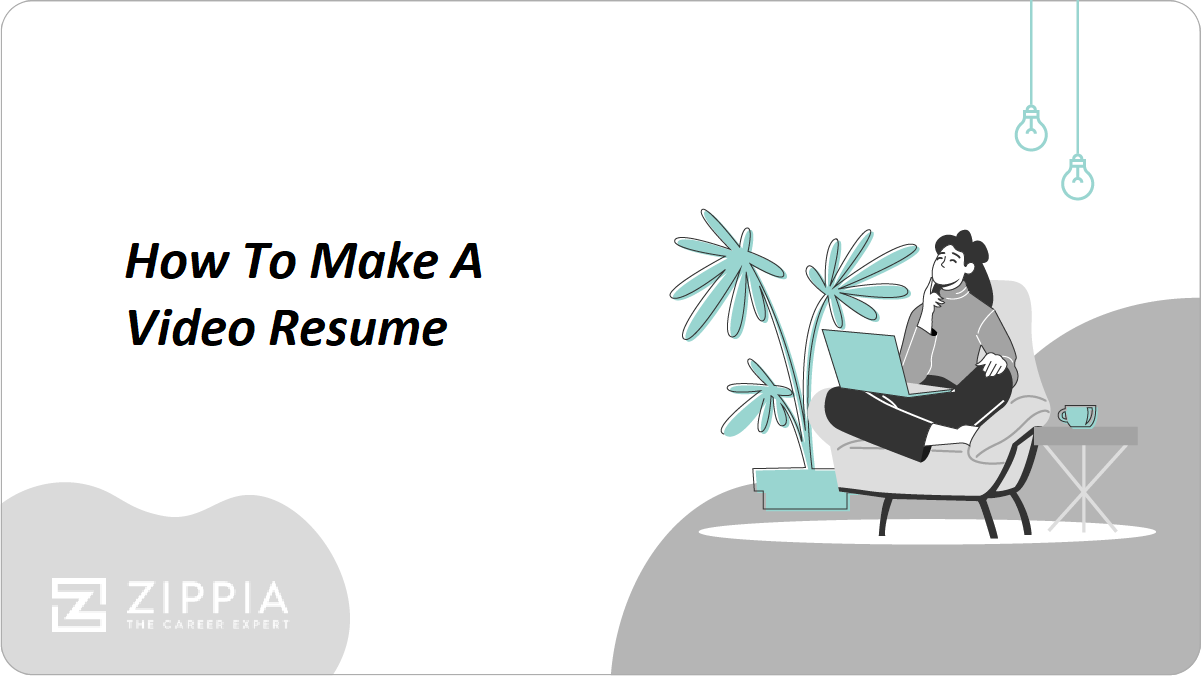
How To Make A Video Resume

How To Add Anticipated Graduation Date On Your Resume
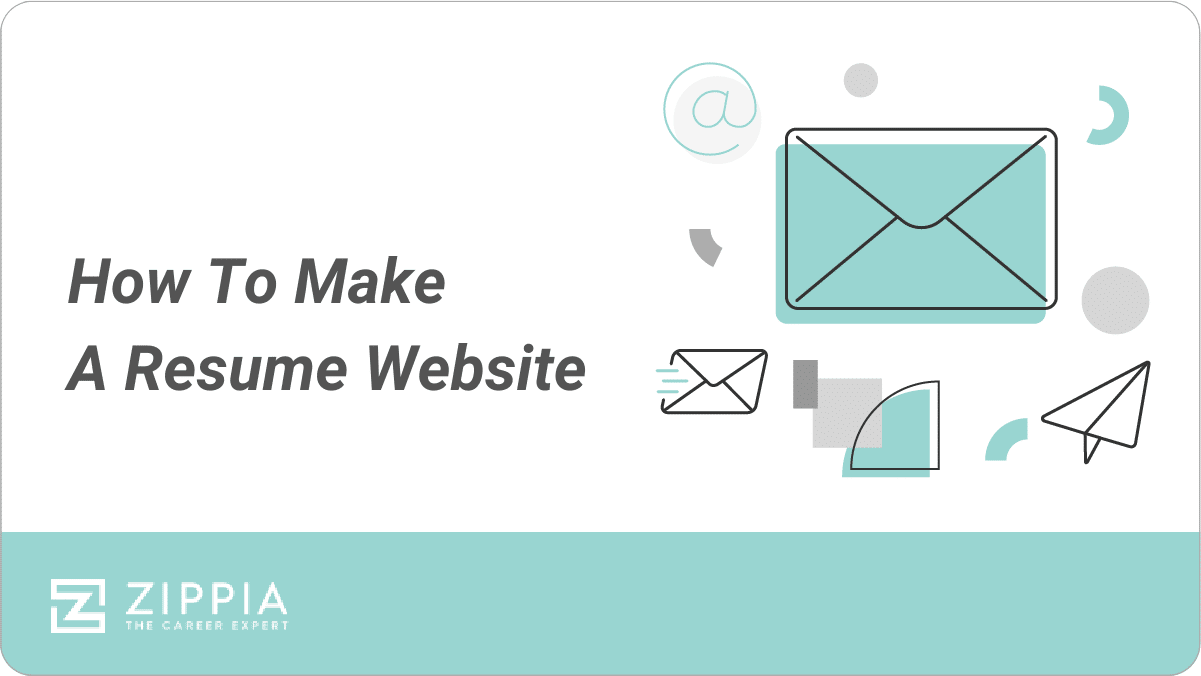
How To Make A Resume Website

Resume Pictures: Should You Put A Picture On Your Resume?
- Career Advice >
- Resume Structure >
- Parts Of A Resume >

IMAGES
VIDEO
COMMENTS
17. Remove References. References can make your resume into a two-page resume. But if you want to make it into a one-page resume, you should remove the references unless the job specifically asks for them. Most of the time, they aren't necessary and take up extra space.
1. List your contact information. Put your name, job title and contact information at the top of your resume. This is true for resumes generally, but it is especially important for one page resumes. You want to be sure the hiring manager knows where to send an interview invitation. To save space, format your name and job title in bold and only ...
Here are several tips for how to fit a resume on one page. 1. Tailor Your Resume. It's okay to have 4-page list of accomplishments. Just don't put it in your resume unless you're going for a senior position. Customize your resume for each past job. Show 3-5 achievements that fit best with this job offer.
One-page resume examples & templates. Explore the professionally crafted one-page resume examples and templates below in each of the three resume formats. We also recommend browsing our library of 800+ resume examples to get inspired by real-world resumes for different jobs, industries and career levels.
3. Clean. Download This Free Template. This one page resume template has a side-aligned header that frees up the entire top of the page. This additional space gives you room to elaborate on your greatest career accomplishments. 4. Hybrid. Download This Free Template.
Here's a template you can use to write a one-page resume: [First name] [Last name], [Degree or certification if applicable] [Two to three sentences that highlight years of experience, relevant skills, education or certifications and achievement.] Experience (For the most recent role, list 5 experience items.
While you're messing with the line spacing, go ahead and set your entire resume to 10-point font (except your name, which should be 14-point or more). 5. Shorten Bullets. Your bullet points are really the meat of your resume. This is where you actually talk about your experience.
Reduce margins and font size. You can reduce your page margins to 0.5 inches and font to 11 or 10 points to give yourself a little more room when trying to fit everything onto one page. But don't use a font smaller than 10, or margins less than 0.5, as this will make your resume cramped, harder to read, and overall less professional.
Use numbers or percentages to showcase your impact in previous roles. For example, instead of saying "led a team," say "managed a team of ten employees, resulting in a 30% increase in productivity.". This approach highlights the value you bring to the table and can set you apart from other candidates.
Content. Top ↑ 6+ One-Page Resume Templates for Online Resume Builders #1 - Simple by Novoresume #2 - Creative by Novorésumé #3 - Modern by Novorésumé #4 - College by Novorésumé #5 - Executive by Novorésumé #6 - Basic by Novorésumé 8+ One-Page Resume Templates for Microsoft Word #7 - Elegant Dark Microsoft Word Resume Template #8 ...
Updated June 24, 2022. Keeping your resume to one page helps hiring managers see your best qualifications quickly. When you submit a one-page resume, you demonstrate the top qualities and skills that make you right for the role. Looking at your previous work experience can help you decide which accomplishments are worth keeping on your resume.
Yes, your resume can be one page, regardless of experience. Single-page resumes focus on the most relevant parts of your work history. Put important and relevant information first, as this makes for an efficient format for any professional field. If you can't fit all relevant experience on a single page, only then go for a two-page resume.
Start creating your one-page resume. A one-page resume can showcase your skills in a concise and impactful way if done correctly. And while a single-page format might not be for everyone, it can be particularly effective during the first 10-15 years of your career. Using a one-page resume template, like those in the Teal AI Resume Builder, will ...
Use digits instead of written numbers. To save space on your resume, consider using digits instead of written numbers wherever possible. For example, you could write "increased sales by 25%" instead of "increased sales by twenty-five percent.". This will help keep your resume focused and concise.
A well-written resume is your chance to make an excellent first impression on the hiring manager. Follow these steps to create a one-page resume: 1. List your contact information. You need to list your contact information. Put your name, phone number, email address, street, city, and province or territory.
For more resume templates like this one, visit our gallery: 15+ Basic Resume Templates to Download. 10. Influx. Influx is just the right combination of traditional and modern. It's a perfect one-pager template for you if you're looking for a way to make your resume look respectable and trustworthy.
Shorten Resume Margin. The first thing you should do to fit your resume into one page is reduced resume margin. Ideally, the resume margin should be 1 inch on all sides. But if needed, you can reduce the resume margin to 0.5 inches on all sides. But not less than that.
4. Experiment with multiple columns. Your word processing app defaults to a single column. However, it's possible to create 2 or even 3 columns on a document. If you're finding it difficult to get your resume down to a page, you may be able to use a 2 column or 3 column layout to get more information on the page.
Sometimes, a candidate only gets one page to make their case. In the recent past, the standard advice was that all entry-level professionals should have a one-page resume, max. However, that's not necessarily the case today, since many recruiters and hiring managers expect to see a two-page resume regardless of the level of experience.
First thing's first — get rid of your resume objective statement, high school experience, and any mentions of " references available upon request .". Also, unless your employer specifically asks for it, ditch your GPA. Now that you're on a roll, it's time to get rid of those boring soft skills.
You can personalize this one-page resume template by changing the color of the left column and the section headings. 2. Classic CREATE MY RESUME NOW. The name of this one-page resume template says it all. It's a classic, one-column layout featuring all standard resume sections. The minimalist timeline added to the work history section makes ...
One of the most time-consuming elements of applying for new jobs is customizing your cover letter and resume for each new role that you apply for. With Canva's free resume builder, all your cover letter and resume designs are saved automatically within the editor. Create multiple versions of your resume, and make small edits where needed.
Keep it short and concise. Combine and consolidate the "Anything IT" paragraph and "Hands-on" paragraph. Change "Technical Proficiencies" to "Technical Skills". I think you should aim for front & back. Still one page. The paper matters too make sure you are using paper that is at least 25% cotton.
Stuffing your entire professional life into a single page resume can feel overwhelming, but remember that you're distilling the relevant parts of your professional experience in order to catch the eye of the recruiter. Formatting your resume. To start, use a word processor such as Microsoft Word or Google docs. Standard resume formatting ...
Whether you're a college grad or looking for a career change, you need a compelling résumé to show you're the best fit for a position. Here's how to make one.
Handwriting your resume comes across as unprofessional and makes your resume hard to read. You can easily make a resume in Word, and even if you don't have access to an online resume builder or a Microsoft Word subscription, there are plenty of free options (like Google Docs or Pages) for putting together a resume.
To create a resume using a Microsoft Word template, follow these steps: Choose your template in Word. To create your resume from scratch, click "File" in your Microsoft Word menu (you can also hit Alt+F on a PC or Command+F on a Mac).Click "More templates" to see a selection of resume layouts.
To do this, the OWL team is always exploring possibilties for a better design, allowing accessibility and user experience to guide our process. As the OWL undergoes some changes, we welcome your feedback and suggestions by email at any time. Please don't hesitate to contact us via our contact page if you have any questions or comments.